“You can measure the depth of a person’s awakening by how they serve others” – Kobo Daishi, Japanese Buddhist monk

JAPAN – Part 7
Osaka Area
Osaka is the third-largest city in the country, with a population of over 19 million people.
One of its most popular areas is Dotonburi, a bustling entertainment district known for its neon lights, street food, shopping, and multitudes of people. Another must-see attraction is Osaka Castle, historic symbol of the city for centuries.
Osaka is also famous for its cuisine, which includes dishes like takoyaki (grilled octopus’ balls), okonomiyaki (savory pancakes), and kushikatsu (deep-fried skewers).
We met May, our city guide upon arriving in Osaka. She asked us if we wanted to visit another temple or if there was anything else that we wished to see or do. Yes! Let’s go food shopping; with her help we’ll be able to translate labels and find the foodstuff we want to drag home.
So off we went to the gourmet food department of Daimaru, a popular department store chain in Japan.
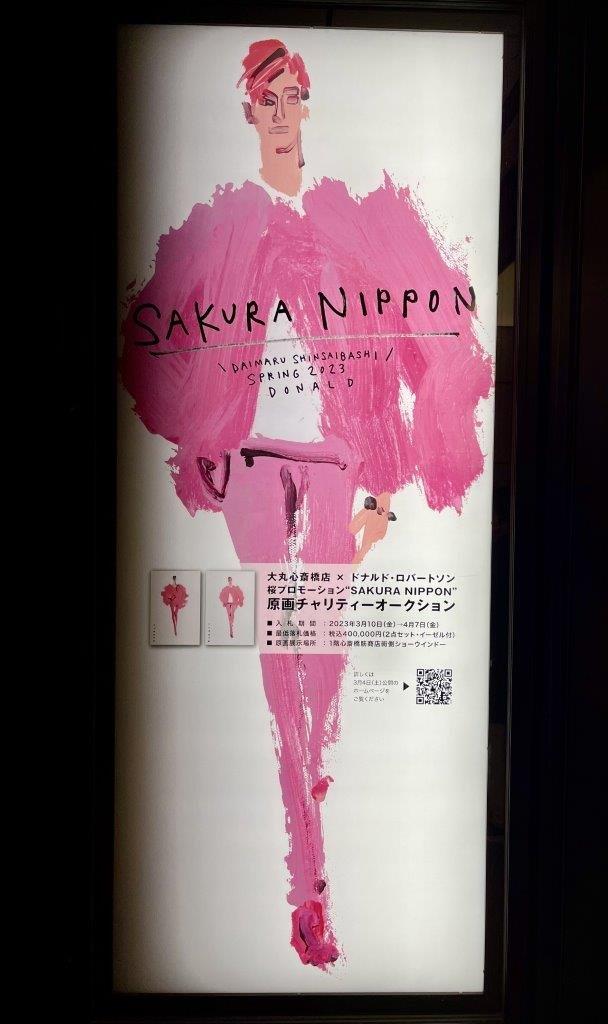
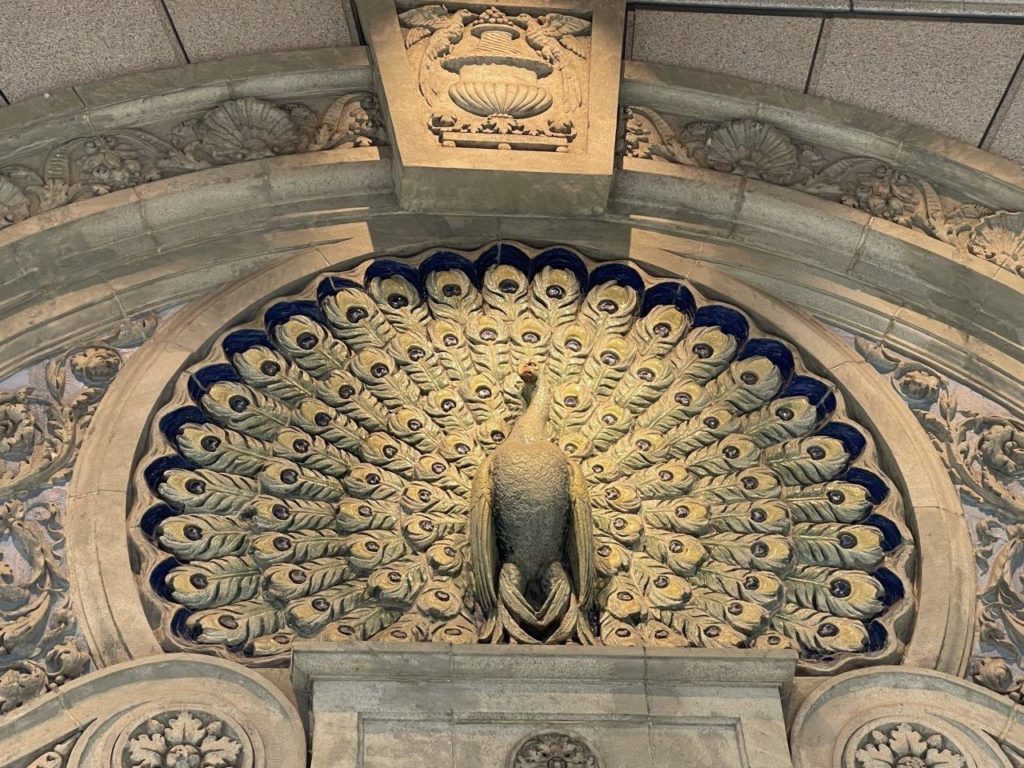
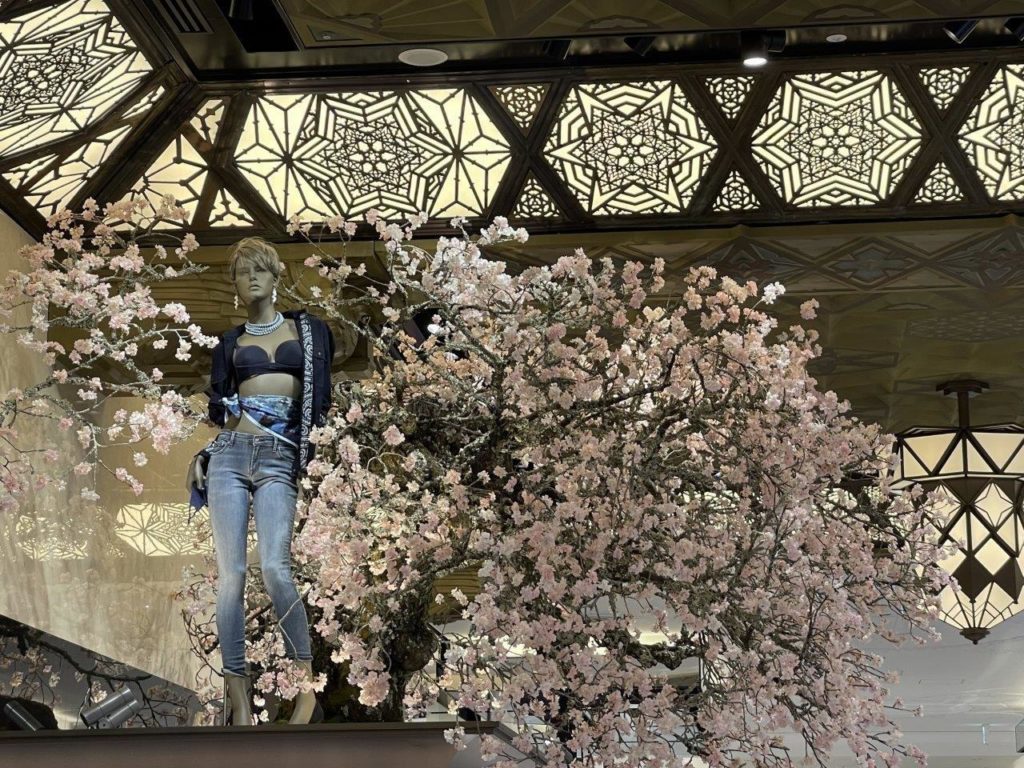
The store is divided into several floors, each offering a different category of luxury branded goods. We headed straight for the large food hall, offering up a beautiful and artful presentation of a variety of gourmet foods. There were several restaurants and cafes offering a wide variety of cuisine.
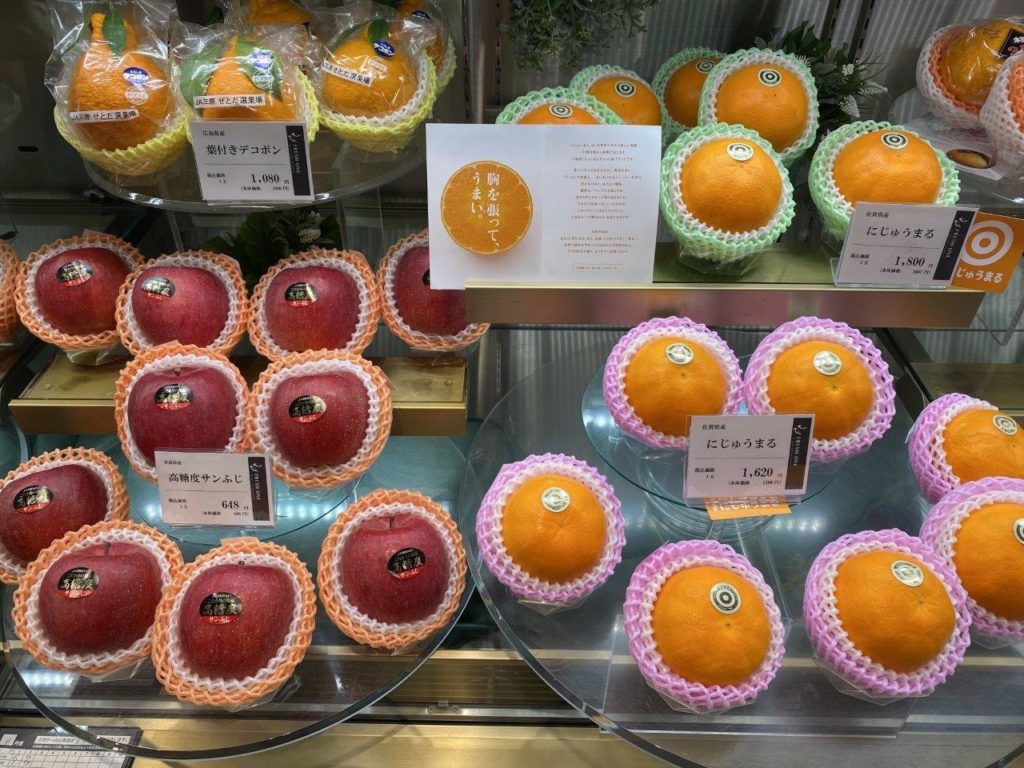
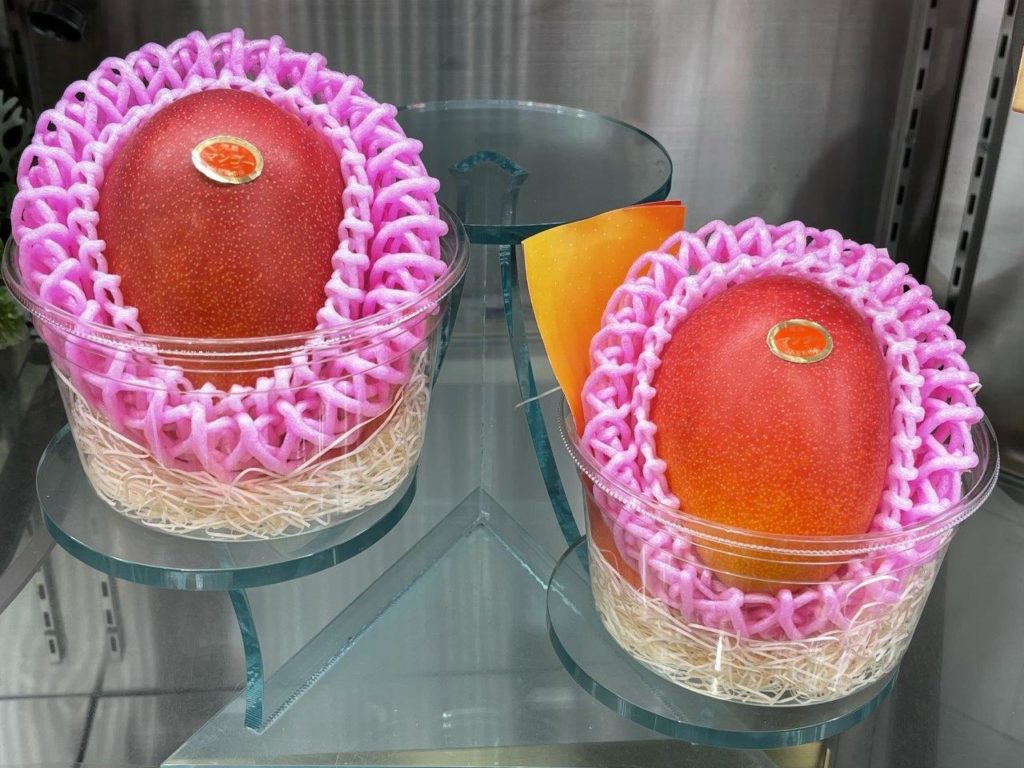
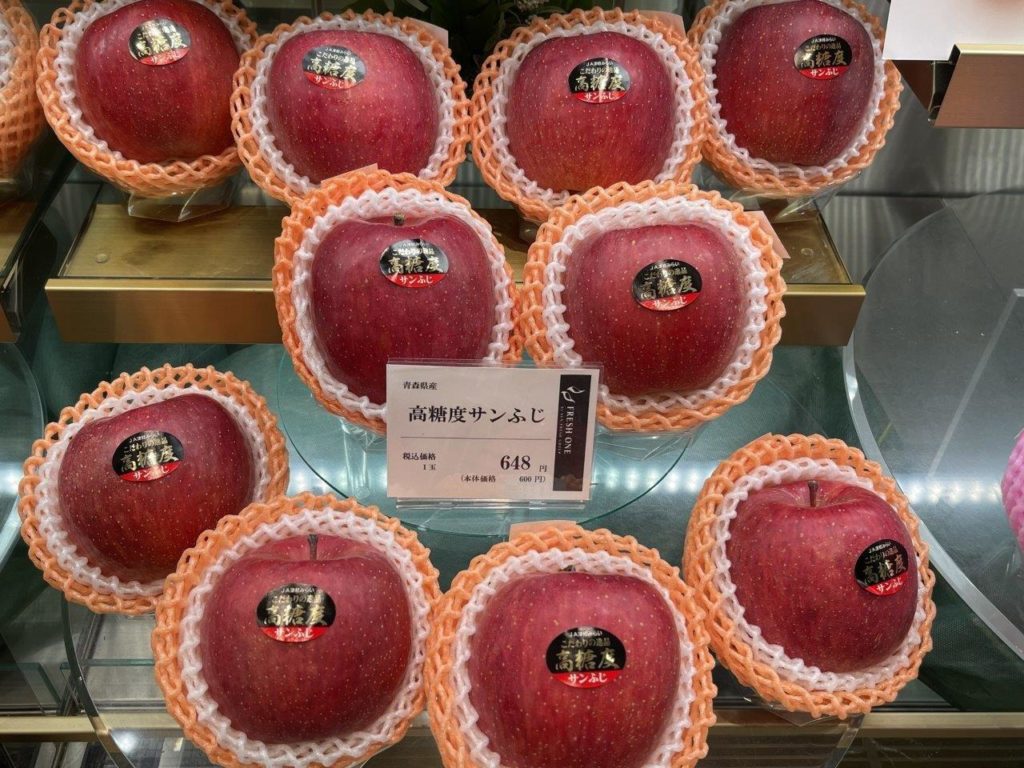

With May’s help, we shopped for spices, seaweed, bonito flakes, and of course sweets and candy.
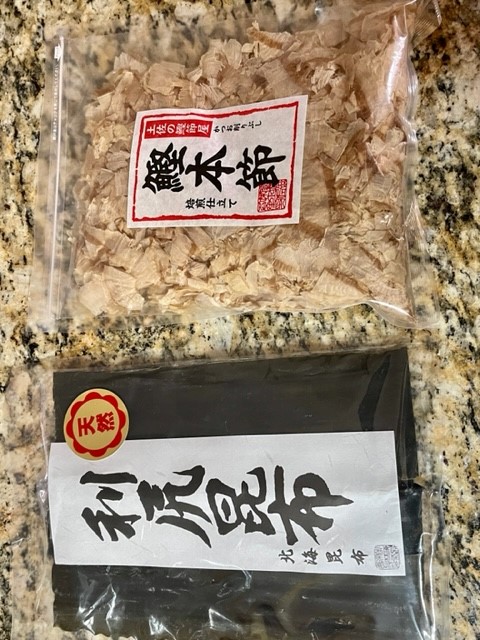
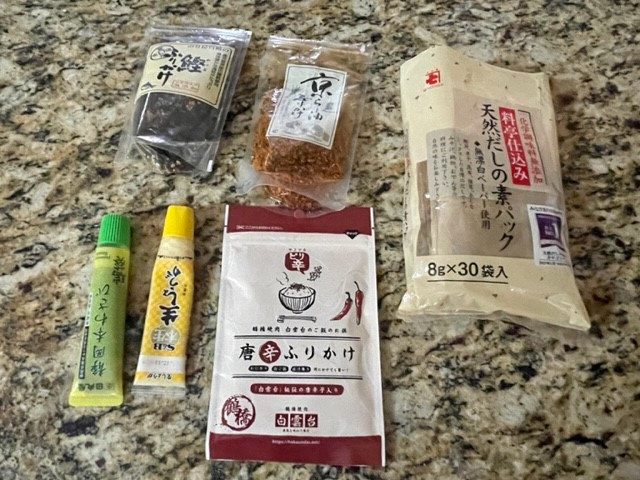
Remember the omelet pan from our Kyoto cooking class? David mentioned it to May, and off we went to a side alley street where you could find and buy anything imaginable for the kitchen. Pan in hand, it was a good afternoon. Should have looked at the knives, but their displays were intimidating.

After our shopping was done, May took us to another alley to experience Osaka-style Okonomiyaki; where tempura scraps (tenkasu), and pickled ginger are often mixed into the batter for added flavor and texture, differentiating it from the Hiroshima-style Okonomiyaki (multi-layer pancake and toppings).
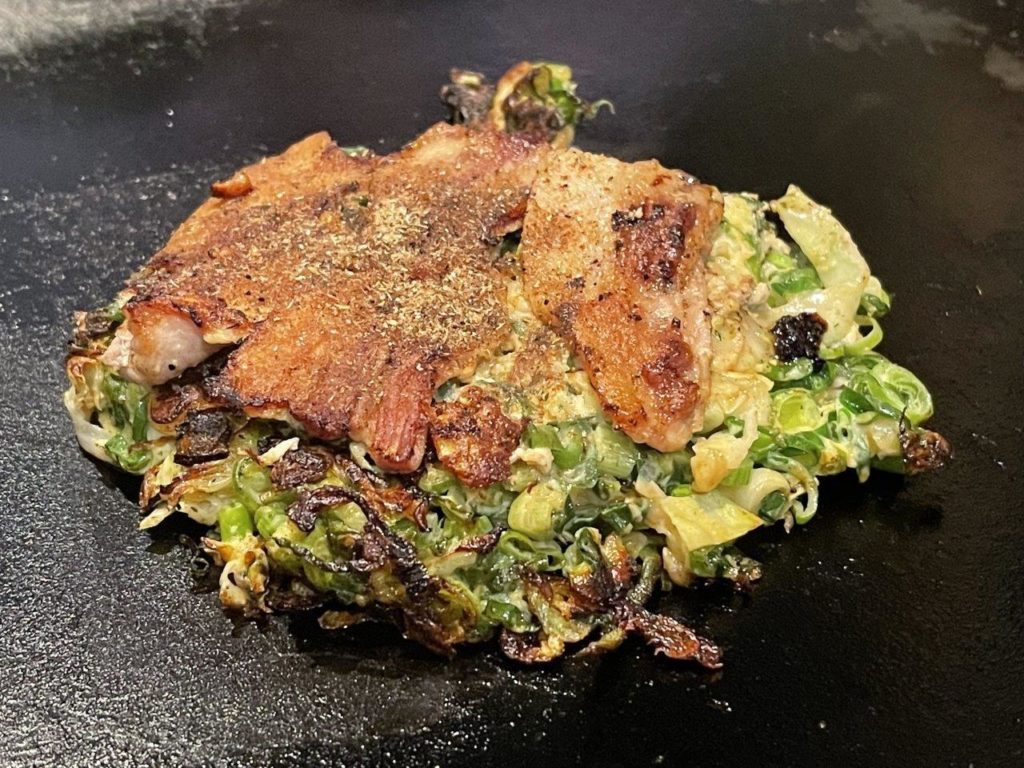
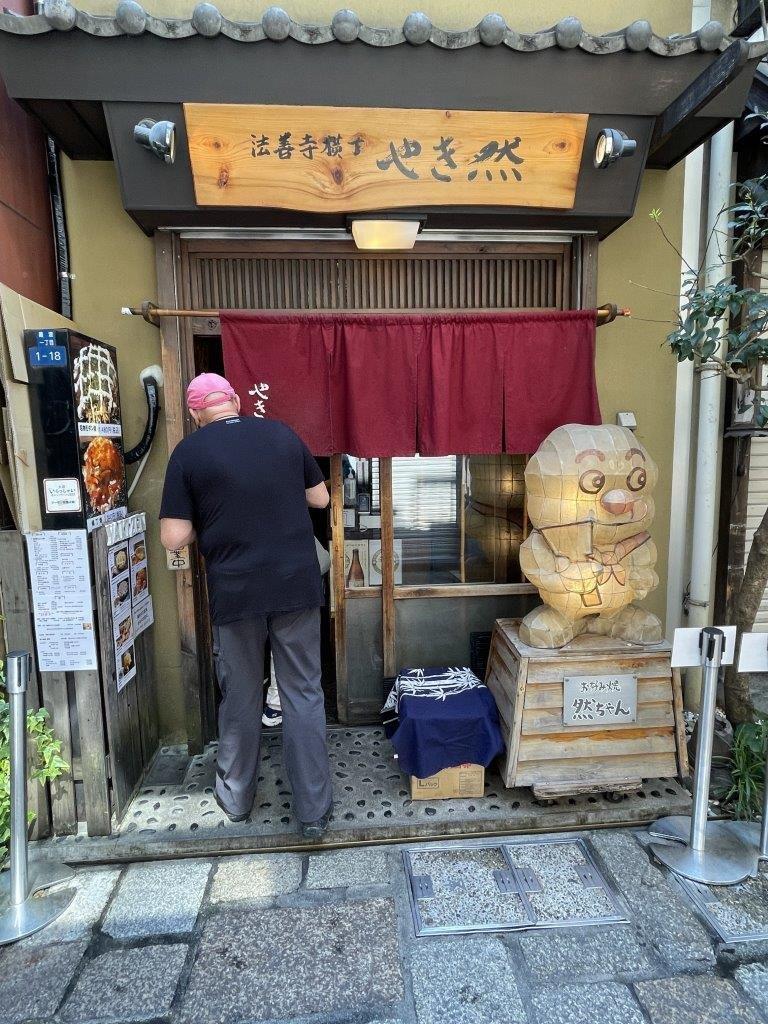
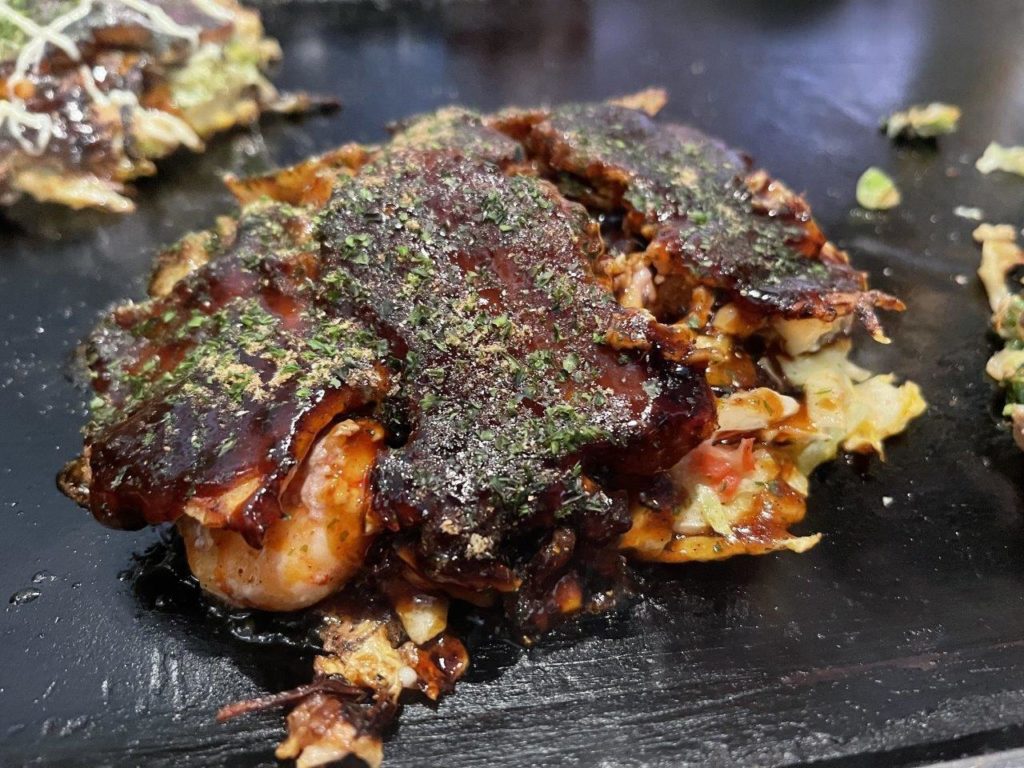
Our hotel was a stone’s throw away from the madness of Dotonburi. The neon lights of the district reflected in our hotel room windows, beckoning us, so that was our next stop.
Dotonburi
Dotonburi is named after the canal that runs through it. This district has a long history dating back to the Edo period, when it was a bustling merchant town. Today it’s a very lively and popular, crowded tourist destination known for its vibrant shopping and entertainment. There are flashing neon lights, jumbo-sized kitschy signs, restaurants, food stands, theaters, and shops. Times Square on the Canal.



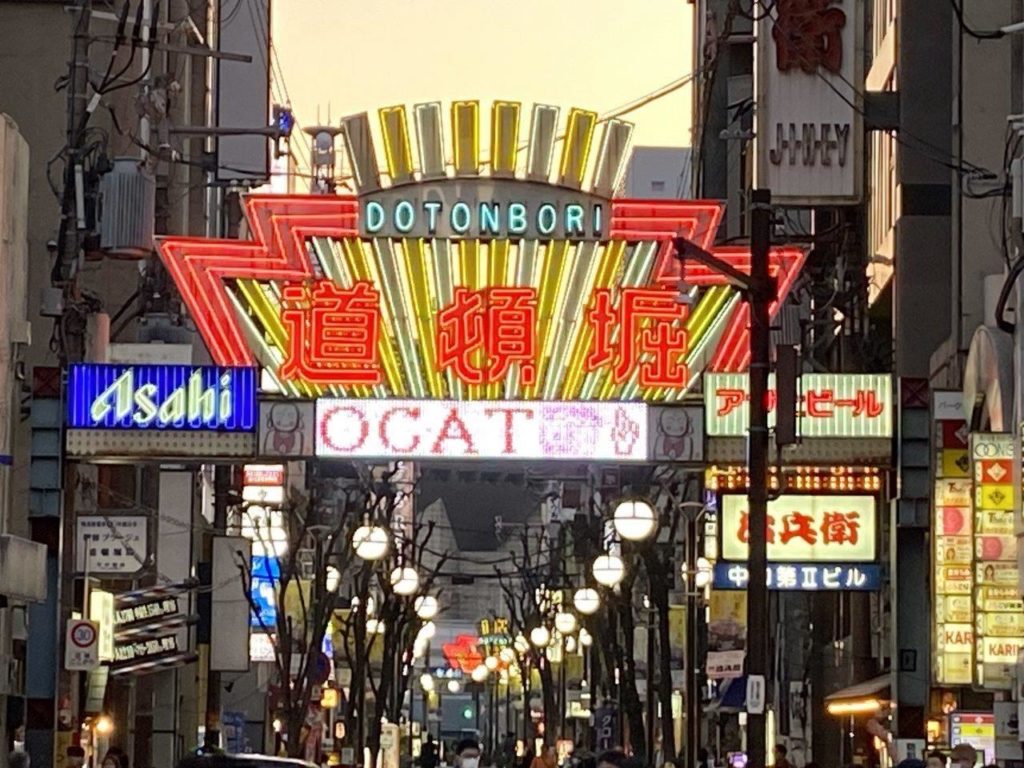
The “Glico Man” provides the perfect photo op. For 88 years, this happy camper has loomed large and famously on his giant, brightly lit billboard, advertising the Glico confectionary company, famous for Pocky sticks. Stand tall, stretch out your arms, lift your left leg up, and you got The Shot.



Look across from Glico Man and you see the start of the Shinsaibashi shopping mall that stretches almost 2,000 feet long. I hyperventilated just looking at the massive number of humans gathered into this narrow arcade. Just about anything a shopper would want can be found here. Daiso, the famous Japanese dollar store, has a three-floor emporium here; luckily, we avoided it for fear of doing a lot of damage … anyone in the L.A. area knows about the dangers of Daiso shopping.

Some of the must-try dishes in Dotonburi include Takoyaki (fried octopus’ balls), Okonomiyaki (savory pancakes), and Kushikatsu (deep-fried skewers). Besides the miles of neon signs advertising dining, some places have opted for a more fun approach, depicting giant sized caricatures of crabs, takoyaki, gyozas and my favorite – an angry cook. Would you eat there?!
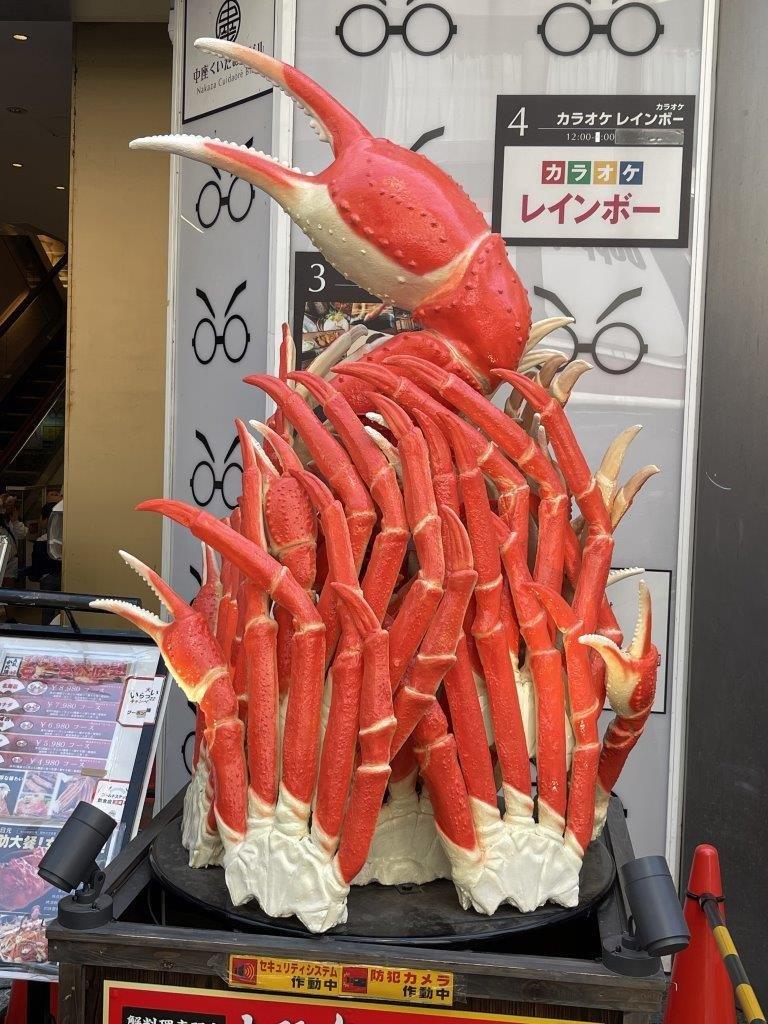


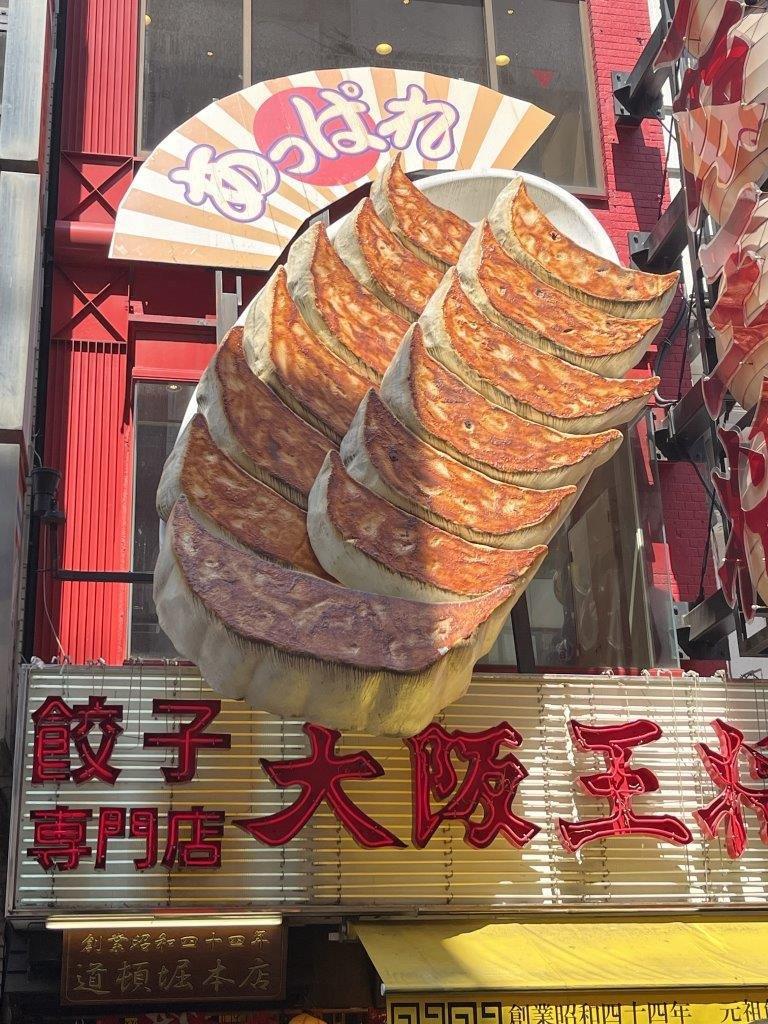
I kept telling David about Takoyaki, a popular Japanese street food that originated in Osaka. It’s a ball-shaped snack about the size of a golf ball, made from a wheat flour-based batter, and is typically filled with diced octopus, green onions, and pickled ginger. The batter is poured into specially designed takoyaki pans that have several round molds. As the batter cooks, the filling is added, and the balls are rotated with skewers to ensure they cook evenly.
Once the takoyaki balls are golden brown and crispy on the outside, they are traditionally topped with takoyaki sauce, a thick and savory sauce like Worcestershire sauce. Other common toppings include mayonnaise, dried bonito flakes (katsuobushi), and seaweed powder (aonori). Takoyaki is often served piping hot, so we ordered the fully loaded combo of a dozen balls.
The place we chose had a line of about 25 people. We waited patiently for our turn, used the self-serving ticket order, handed over our tickets, got our food and sadly, our dreams were suddenly shattered.


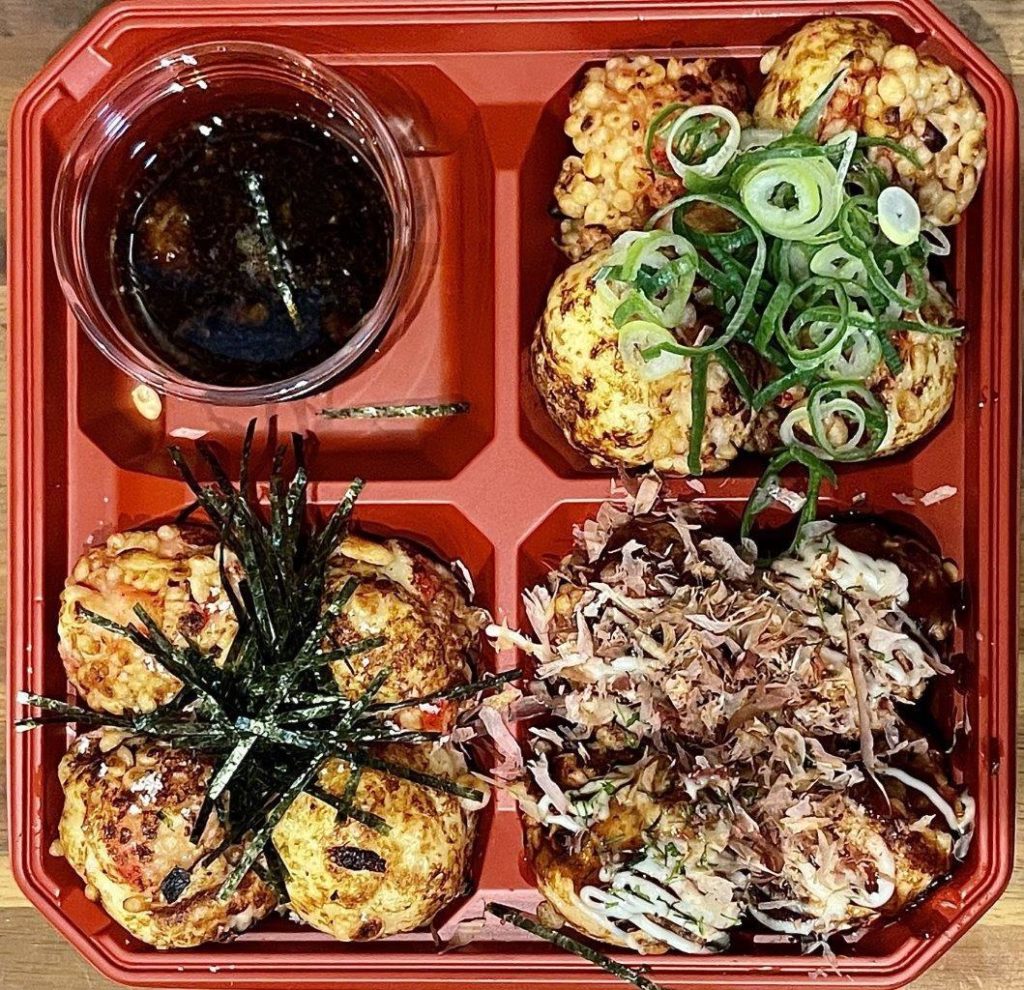
I remember takoyaki to be crispy on the outside and having a chewy, textural center with the octopus. Unfortunately, what we got was a soft outside, a gooey, uncooked middle, and tough octopus center. Two bites from each of us and they went into the trash bin to the horror of surprised onlookers.
Rule of thumb ~ if the place has a line, there are two reasons: either it is good or it is cheap. Well, this was neither good nor cheap. Oh well, a slight food blip.
David first encountered Natas, the Portuguese egg custard tarts (pasteis de nata), on the island of Macao, and he instantly fell in love with this tasty and decadently sweet treat originating in Portugal. A flaky, buttery crust and a creamy, caramelized egg custard filling create one delicious pastry. It is perfection in two bites!
During our honeymoon trip to Portugal, if he saw a bakeshop selling Natas we had to stop and get some; like with his candy, the boy immediately became an addict. He would get his fix in the many Natas shops and restaurants along the way.

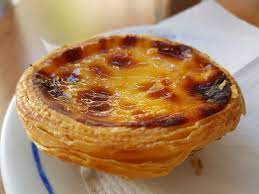
When he found out that Lord Stow’s Bakery, a well-known bakery based in Macau, China, had a branch in Osaka … well, we had to find it. Here, they’re simply called egg tarts.
Lord Stow’s Bakery was easy to find as it was at the entrance to Dotonburi. I bought a box to bring back to our hotel room to happily feast on.
Osaka Castle
One of Japan’s most famous castles is in Osaka. It played a significant role in the unification of Japan during the 16th century and has a long, rich history.
Originally built in 1583 by Toyotomi Hideyoshi, a renowned samurai and military leader, it served as a symbol of power and governance. It has gone through several reconstructions and renovations over the centuries due to wars, fires, and natural disasters.
The imposing architecture is a blend of traditional Japanese and defensive elements, including multiple layers of white walls and moats. The main tower stands five stories high, providing panoramic views of the surrounding cityscape from its observation deck.

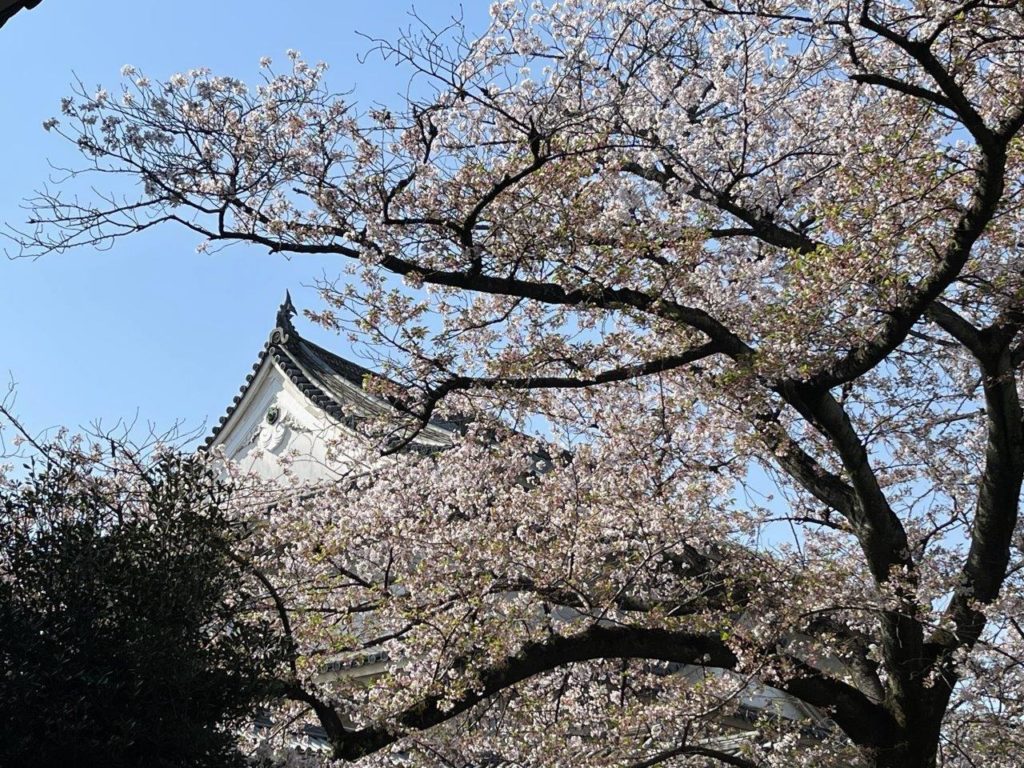

There was a long queue to enter the castle and climb to the top of the tower. David asked me if it was worth the wait. I recalled the palace was mostly empty inside, with a few scrolls and pieces of furniture; the main attraction was climbing to the top and enjoying the panoramic views. His reply, “Nah!” Ah – the beauty of private traveling and making our own quick decisions and skipping out.
So, we opted instead to enjoy the spacious green area with gardens, plum orchards, and cherry blossom trees in all their beautiful pink glory.
Umeda Sky Building
The Umeda Sky Building is a landmark skyscraper completed in 1993 and famously known for its unique design features: two 40-story glass towers that are connected at their top floors with an observatory bridge and escalators. They are enclosed in glass and cross the wide-open atrium space in the buildings’ center. It’s a marvel of man’s ingenuity.
Riding up on the glass-enclosed escalator is startling, and a bit scary in my book. It gives you the impression that you are heading up into the clear blue sky between the two towers, with a long drop to the ground below you!
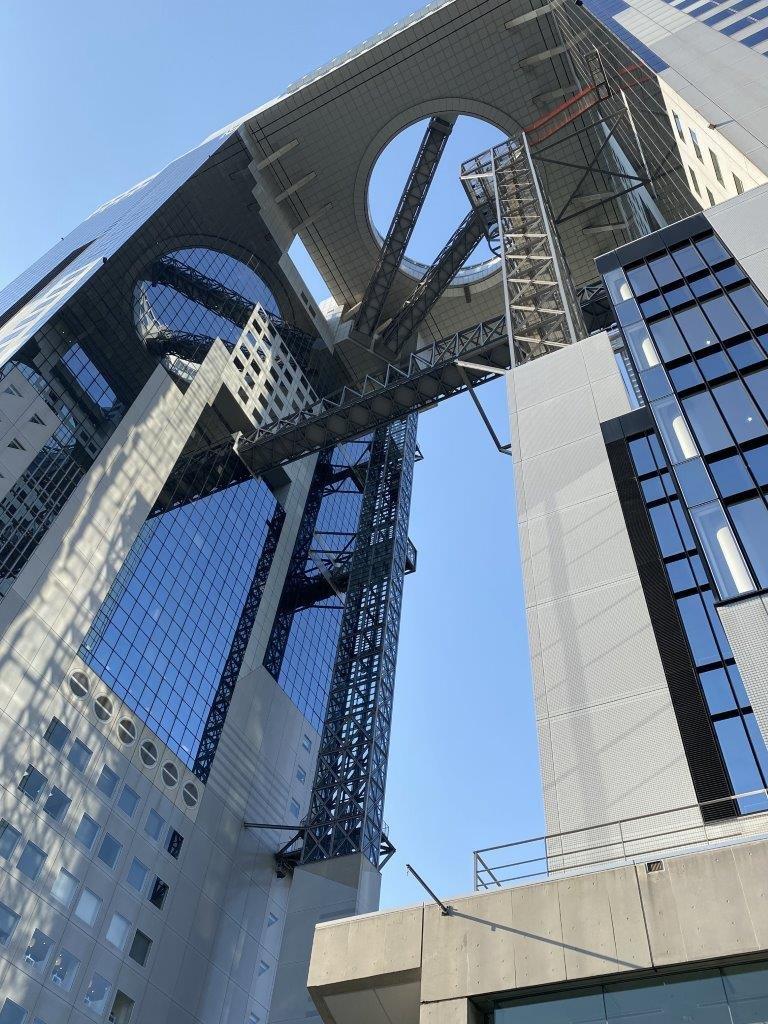
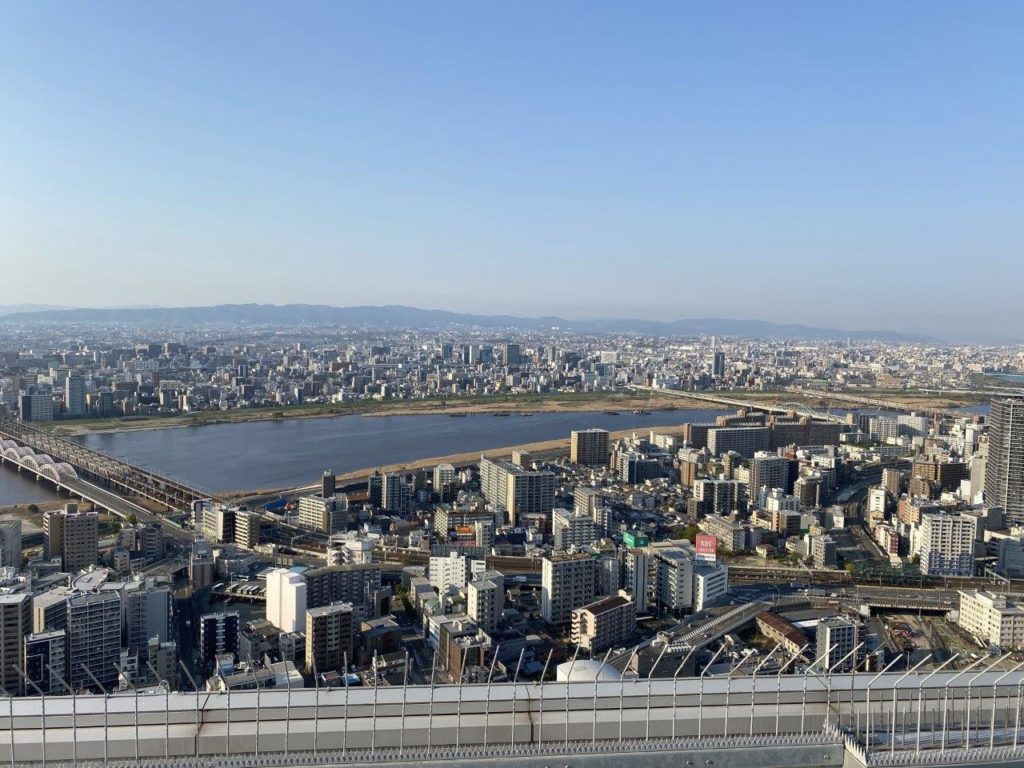

The 39th floor circular observatory, known as the “Floating Garden Observatory,” offers 360 degrees of breathtaking, panoramic views of Osaka and the surrounding area. It can get windy, so hold onto your hat!
Trains
One thing that never ceases to impress me is Japan Railways (JR). We all have had the experience of boarding a train, and choosing seats that are positioned in the direction of travel; avoiding facing backwards which can make some people feel sick. In Japan, that just does not happen.
While standing at the station waiting to board our train to Mt. Koya, I was simply amazed to watch the following procedure happen within our empty train car …
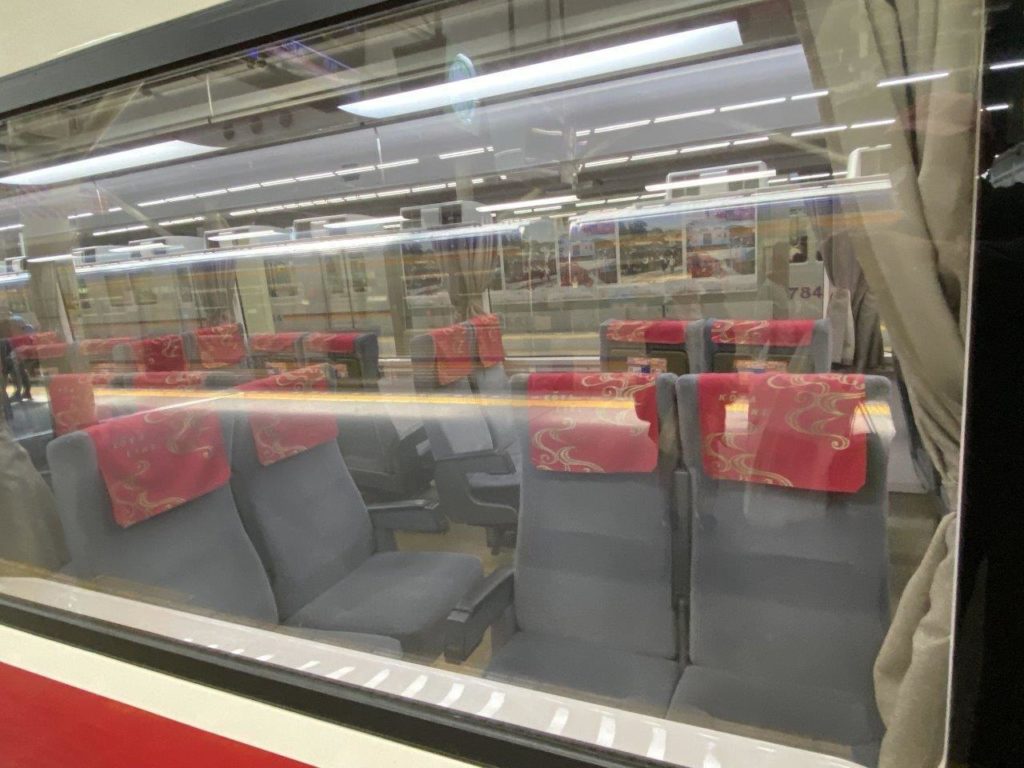
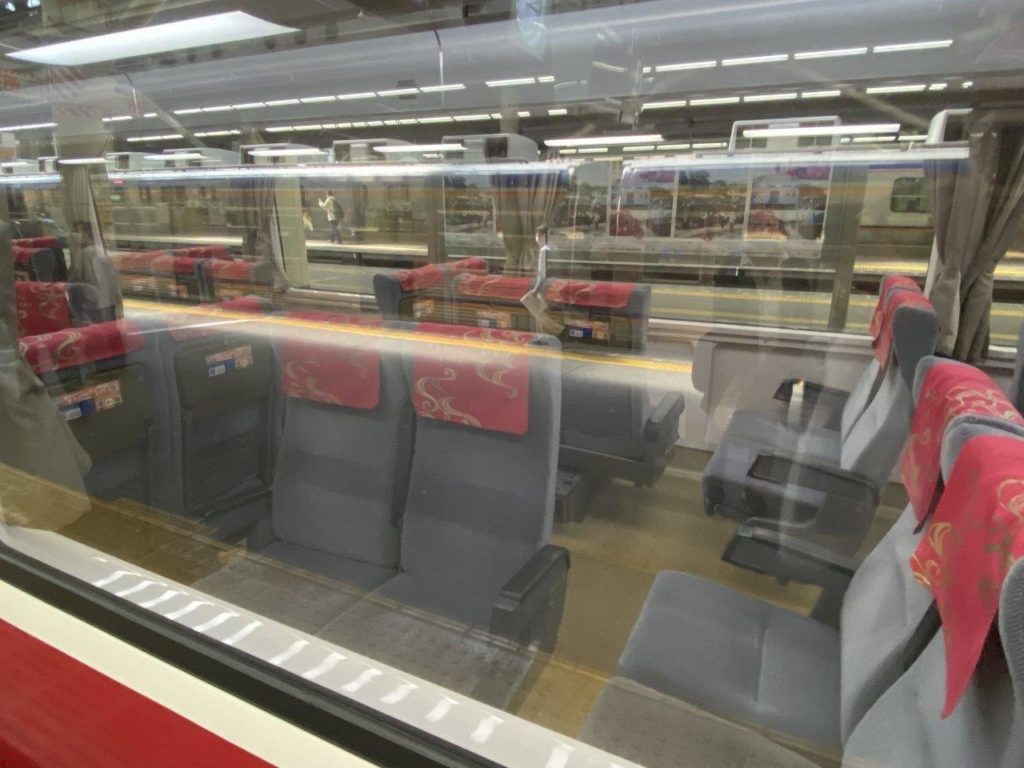
Many trains have a feature known as “automatic seat direction change” or “rotation.” This feature allows the seats in train cars to change direction automatically at the end-of-the-line.
When a train reaches the terminal station, and prepares to head back in the opposite direction, the seats are all rotated to face the new direction of travel. This system allows passengers to sit and face forward comfortably and without undue stress or discomfort.
A brilliant maneuver to behold. It’s an idea that should take hold in trains around the world.
Mount Koya or Koyasan
In order to reach the scenic forests of Mount Koya, or Kōyasan in Japanese, we traveled quite a distance from Osaka via subway, trains, a thrilling five minute, 45-degree cable car/funicular and finally, bus. A remote place, it is the birthplace and center of the Shingon school of Buddhism religious sect. We would explore the religious sites and spend a night at a monastery/temple lodge, living amongst the monks. Holy cow!
Shingon Buddhism is a form of esoteric Buddhism that originated in Japan in the 9th century. It was founded by Kobo Daishi, a Japanese Buddhist monk, calligrapher, and poet, who had studied in China and brought back with him teachings from the Chinese Tantric Buddhist tradition.

At the top of Mt. Koya, there is a fascinating town also called Koyasan, that’s entirely devoted to all things religious, and also a base for recreation and hiking. It’s nestled into a flat basin and surrounded by high mountaintops. There are more than 100 temples, including the headquarters and school of the Shingon sect located within the small, compact area.
Visitors can explore the town and its temples, many of which have been designated as UNESCO World Heritage Sites. The town is a unique and spiritual destination that gives visitors a glimpse into the rich history and culture of Shingon Buddhism. It’s a must-visit for anyone interested in Japanese religion and history.
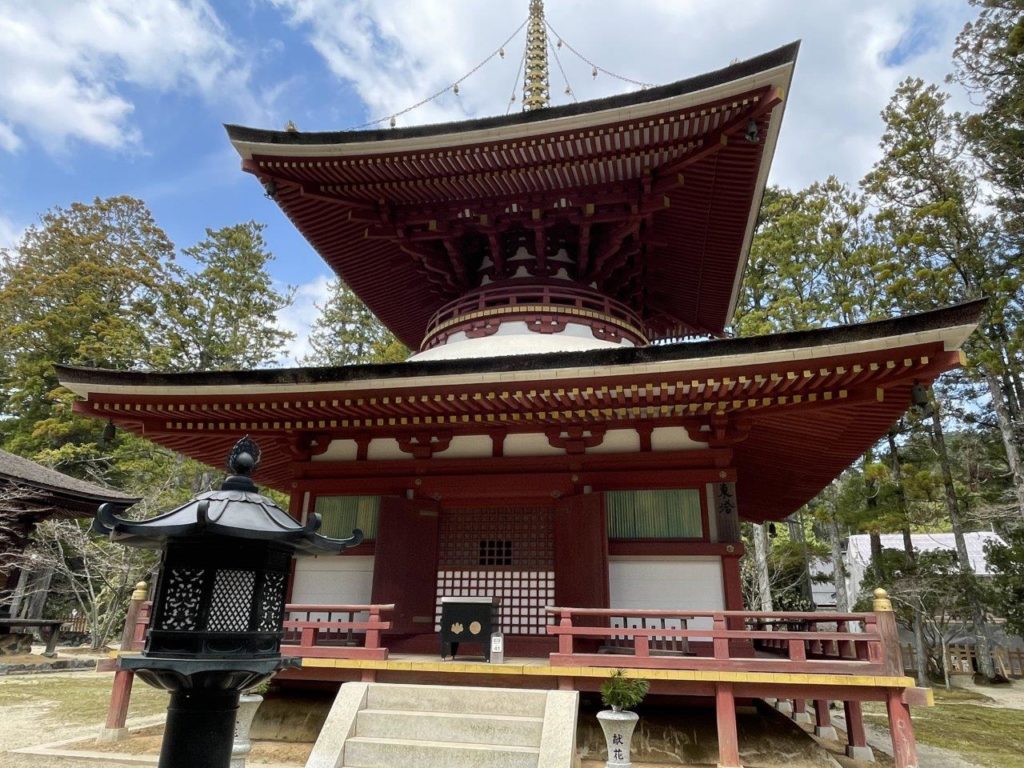

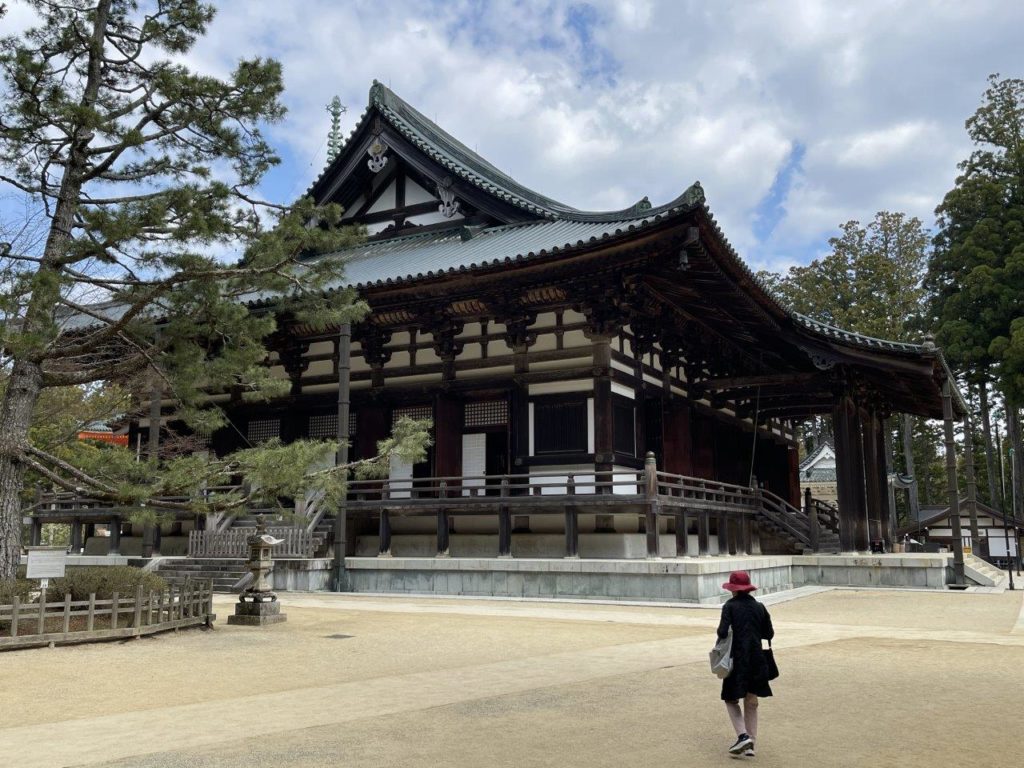

Of a population of seven thousand in Koyasan, almost half are monks, and the rest are their families. Visitors can walk along the picturesque Choishi Michi pilgrimage route, which leads from the town to the cemetery.
A little commercial street allows for tourists to eat and shop. A delicious bowl of ramen was our reward for reaching this outpost. And here, too, we found a locally made bottle of soy sauce to take home.
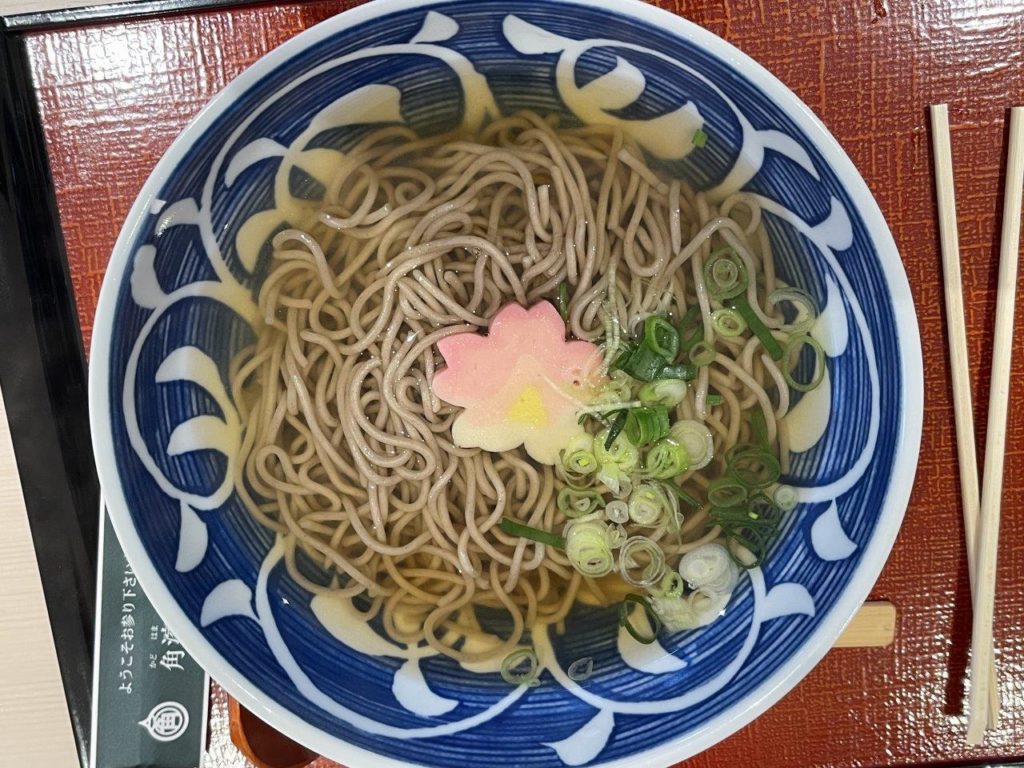
Okunoin Cemetery
Since 816 AD, Okunoin Cemetery has been one of Japan’s most sacred places, and its largest cemetery with over 200,000 gravestones! Located in the ancient forest of Mount Koya, it’s another wonderful UNESCO World Heritage site of Japan, making it a popular pilgrimage destination.
The cemetery is the final resting place of many prominent and historical figures, most notably Kobo Daishi, priest, and founder of the Koyasan religious colony. He’s one of the most revered religious persons of the country, believed to be resting in eternal meditation, awaiting the Buddha of the Future.

Wishing to be physically close to Kobo Daishi in death to receive salvation, many people, including prominent monks and feudal lords, have had their tombstones erected here over the centuries. Pilgrims come to seek relief and salvation. Our tour guide, May, has family resting here.
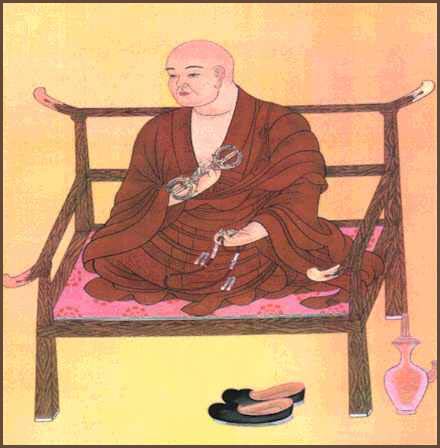
We first entered via the Ichinohashi Bridge, the traditional entrance, and we bowed to pay our respects to Kobo Daishi before crossing the threshold and entering a different world ~ a spiritual one. Thus began an almost two-kilometer tour (1.25 miles) through the beautiful grounds of the cemetery; strolling along the long and winding path through the forest, which finally leads to Kobo Daishi’s sacred mausoleum.


Sunlight would filter through the tall cedar trees, among other varieties that are growing; all appropriate species for the climate and specifically planted to replenish lumber supplies for the town’s rebuilding and repair work. I would say that the monks were early eco-friendly and ecological footprint followers.
Over 200,000 stone lanterns line the path, and each night are lit up, creating a magical and spiritual atmosphere. At the end of the walk, you come upon the Torodo Hall, which is famous for its thousands of lanterns lit to commemorate the souls of the deceased.
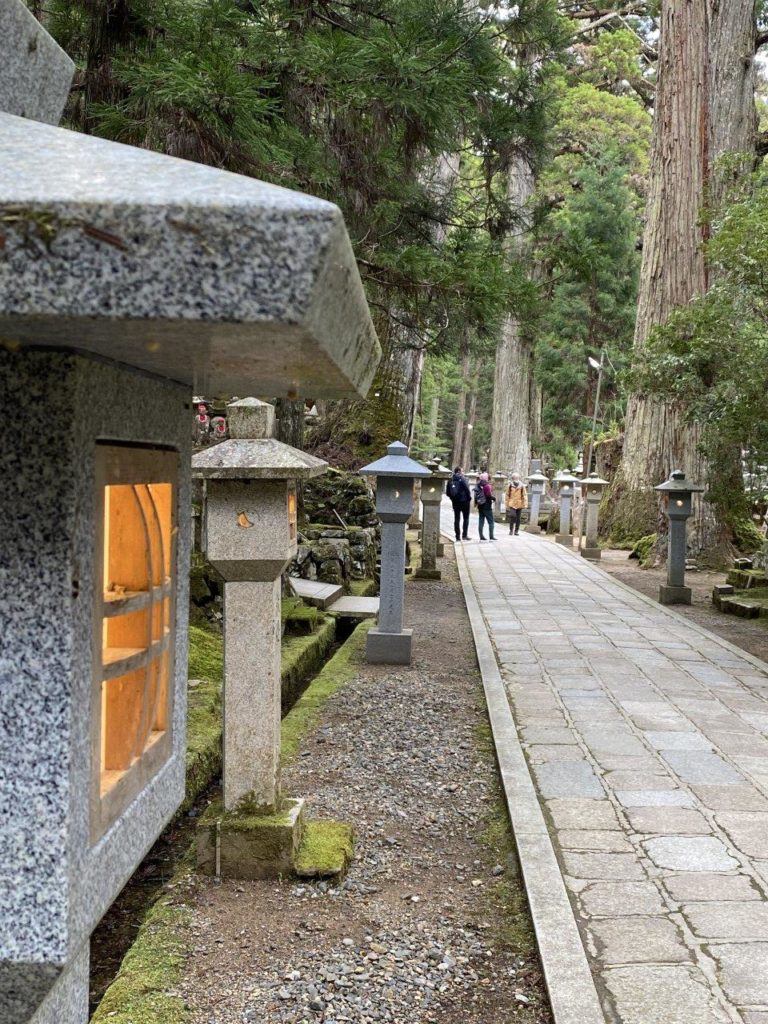
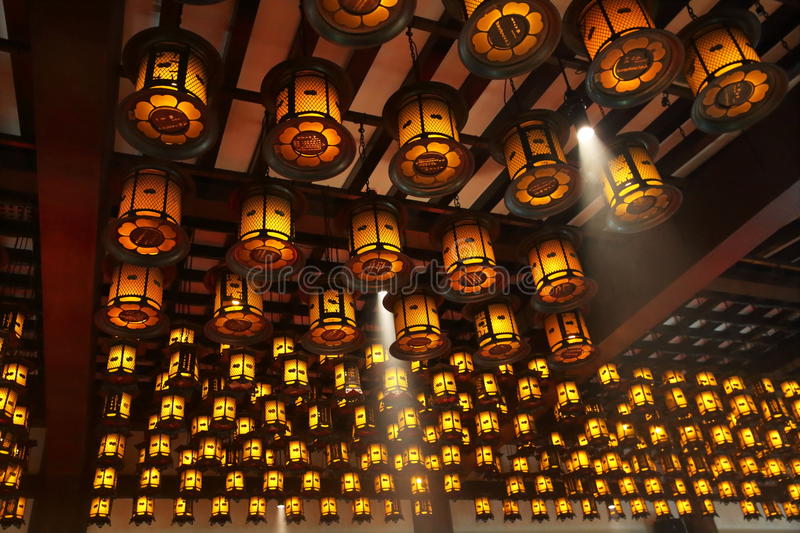
Behind Torodo Hall is Kobo Daishi’s Mausoleum (Gobyo), the site of his eternal meditation. Visitors come from all over to pray to Kobo Daishi, and it’s not unusual to see pilgrims chanting sutras here.
Our little pilgrimage, if you will, was a very serene, peaceful, and meditative *** walk. We had stopped here and there to see up close some of the decorated old headstones. Though we could not read the Japanese inscriptions, you could tell by the size if a gravesite was of an important person, such as a samurai or feudal warlords of yore.
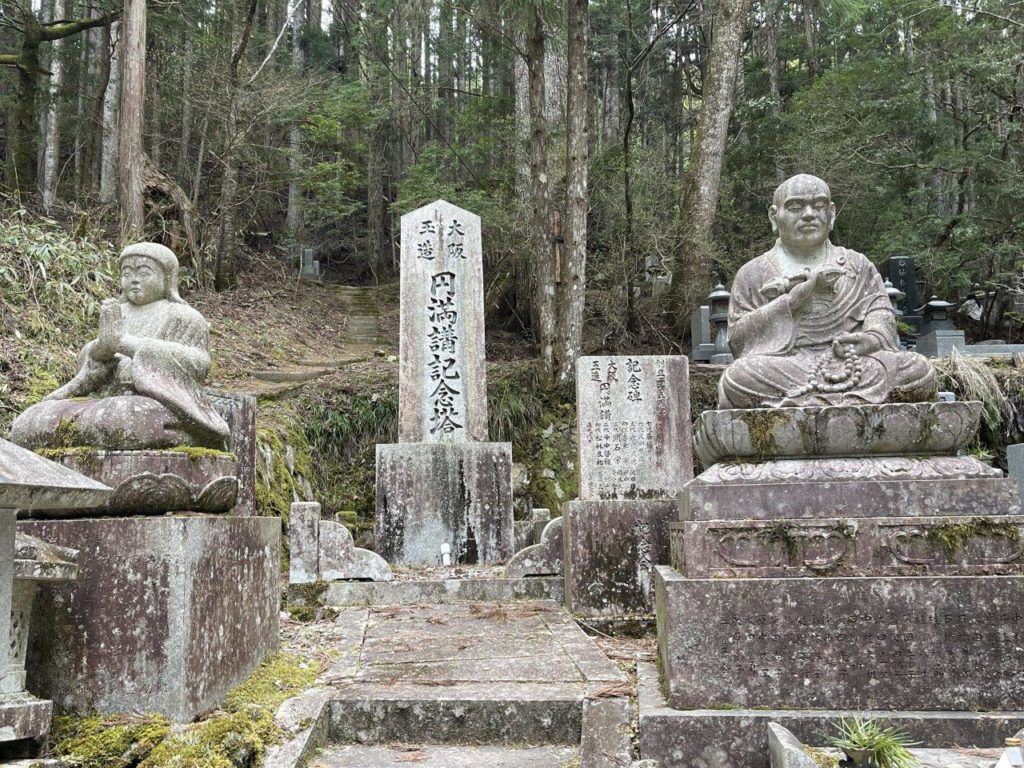
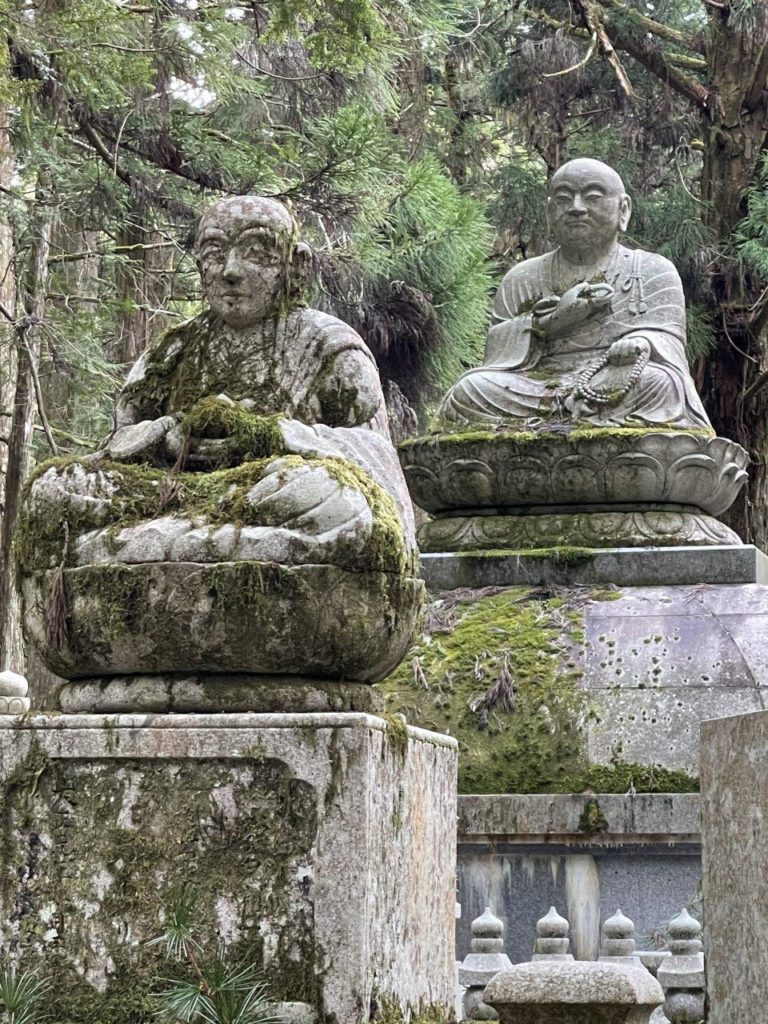
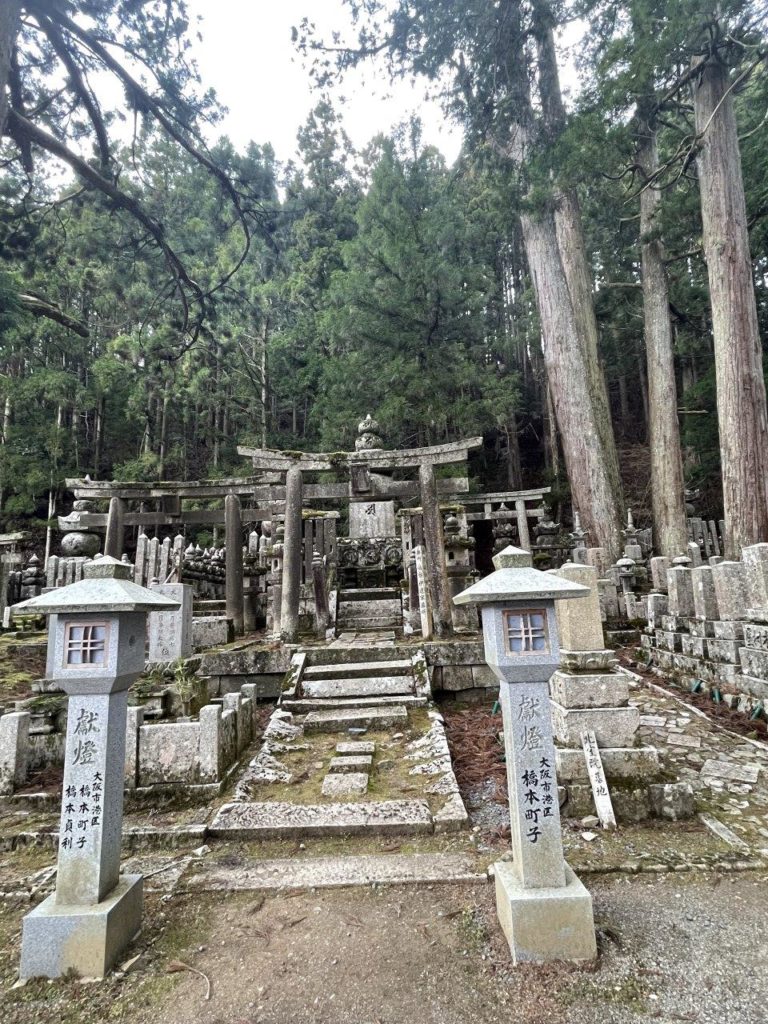
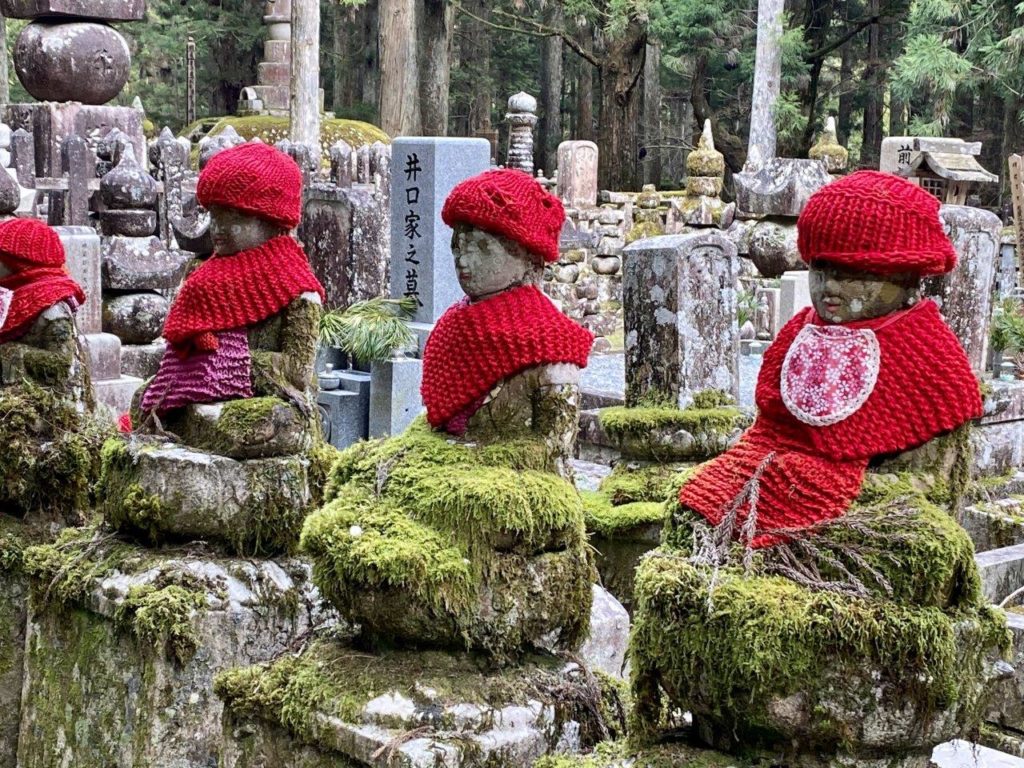

Jizo Bosatsu are stone-carved figurines representing spiritual beings who strive for the enlightenment of all creatures, not just themselves. They’re commonly decorated with little red woven aprons and hats. These tell a tragic story … these small, child-like statues represent the Jizo Bosatsu that protects the souls of children.
Here now are some of the most notable temples found at Mount Koya:
Kongobuji is the head temple of the Shingon sect of Japanese Buddhism, and the largest temple at Mount Koya. It was originally built in the early 17th century and is known for its Karesansui Gardens, “dry landscape,” featuring beautifully placed stones and raked sand.
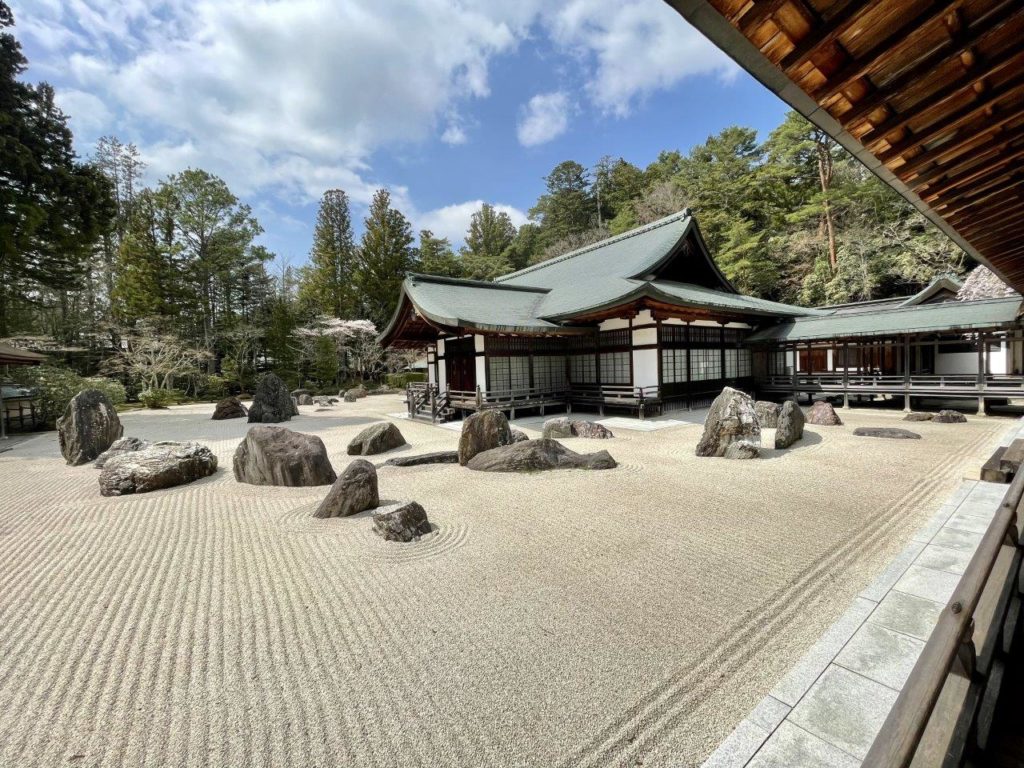
Danjo Garan is a complex of temples and halls located at the heart of Mount Koya and is considered one of the most important sites in Japanese Buddhism. It was originally built in the 9th century and contains several important artifacts and relics.
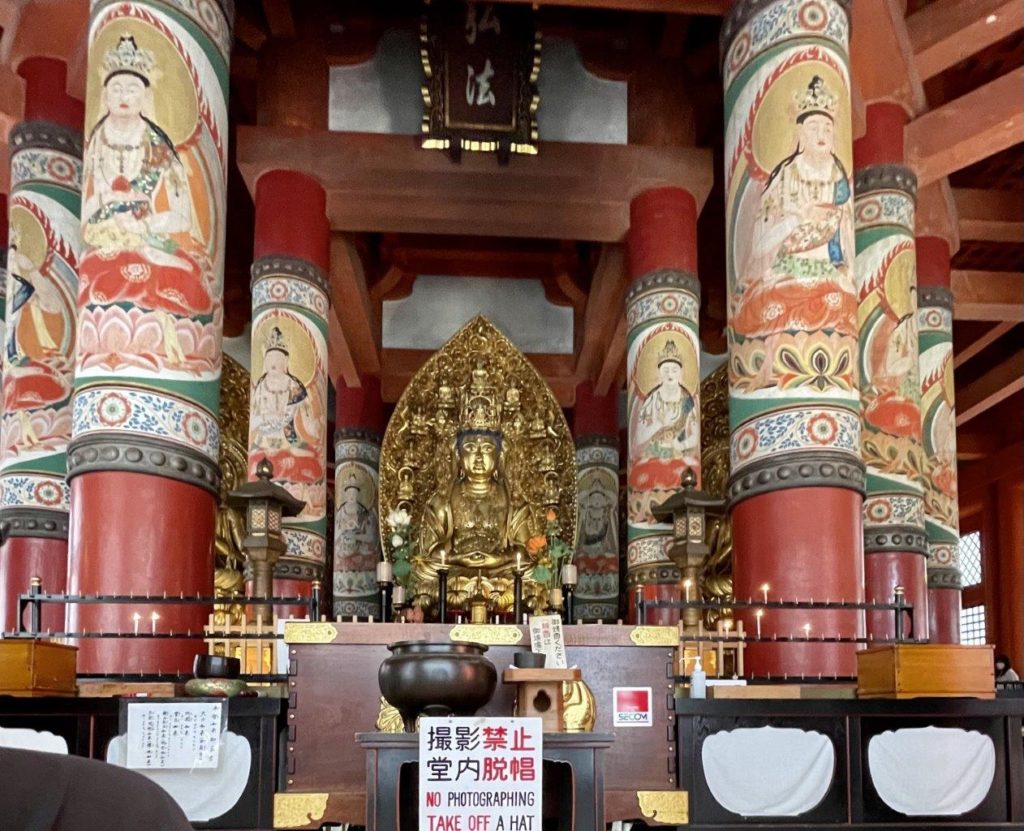
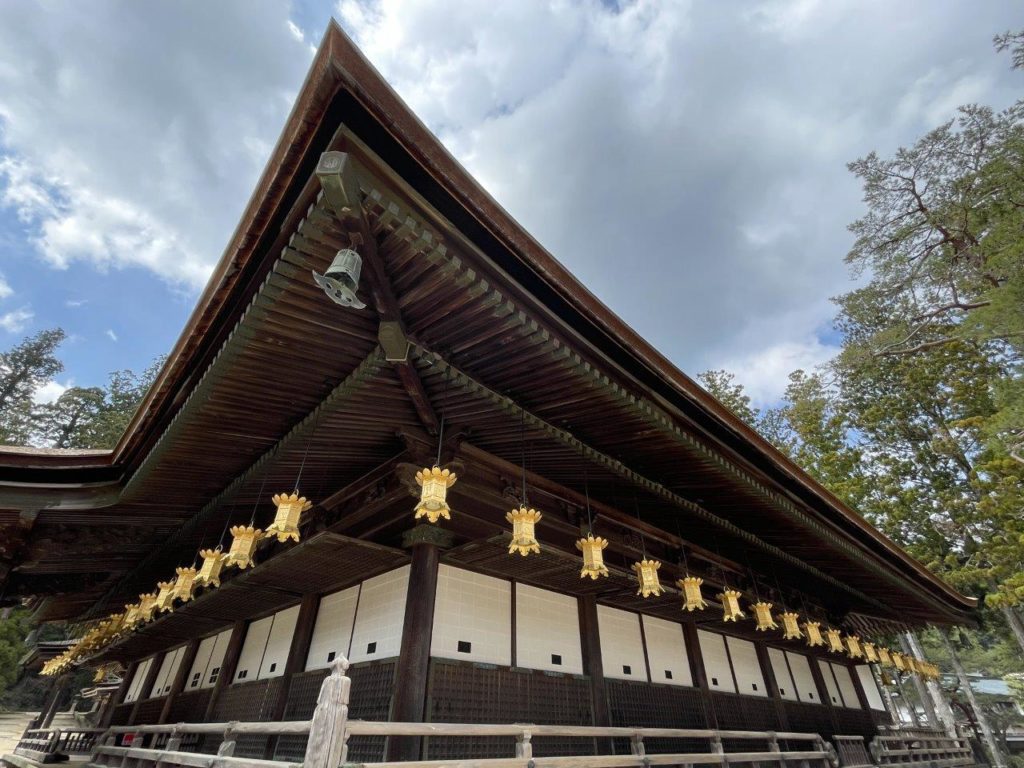
Kondo Hall is within the Danjo Garan complex and has claims of being one of the oldest buildings on the mountain. It’s known for its ornate decoration and collection of Buddhist statues and artifacts.
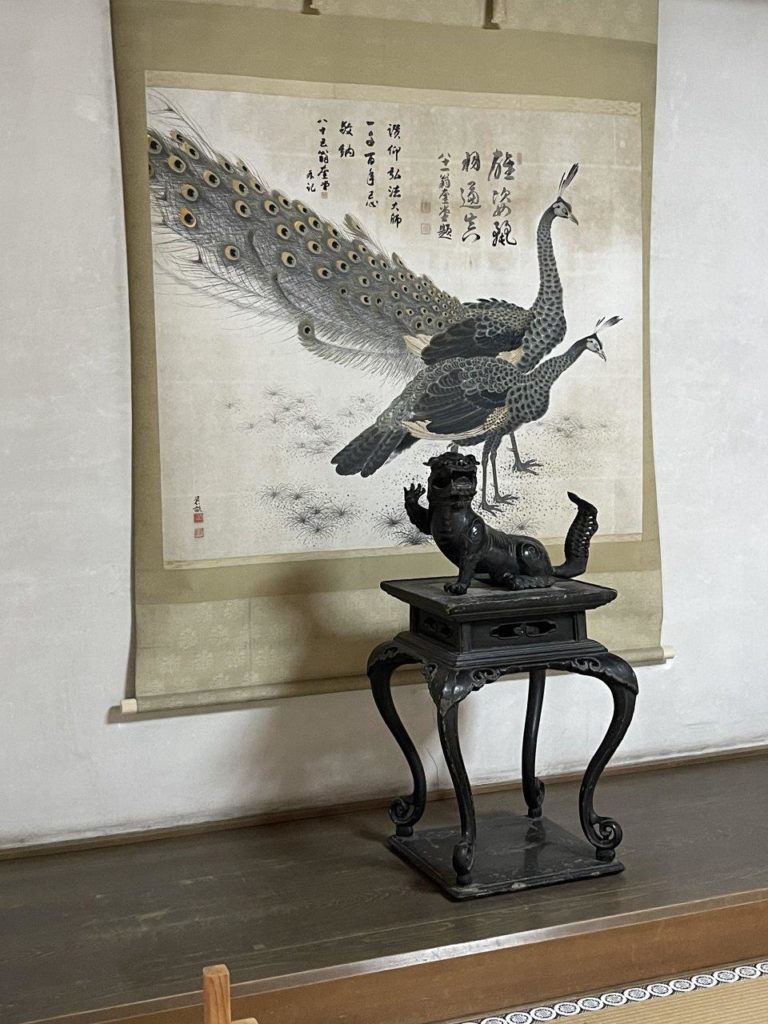
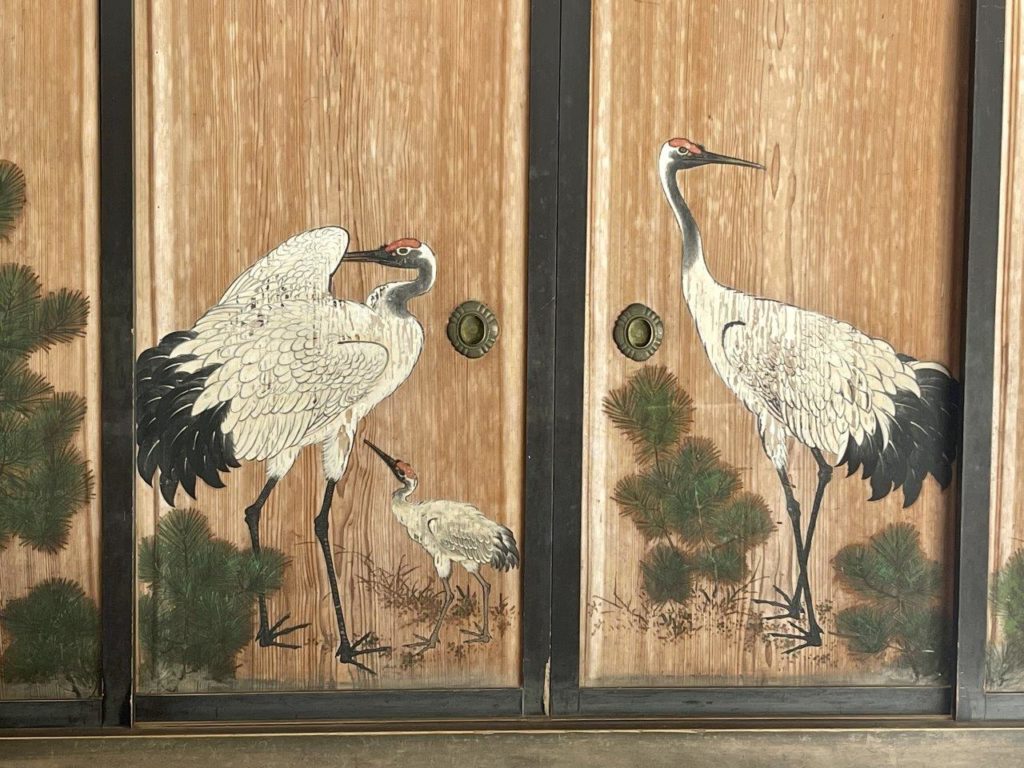

Inside one of the temples, we suddenly heard bells ringing nearby. Outside we caught sight of two monks across the way performing this daily ritual, an important tradition in Japanese Buddhism.
Bells can be rung up to 108 times, which holds symbolic significance in Buddhism. However, at Mount Koya, the bell tolls vary, all depending on the specific temple and its schedule of ceremonies and rituals.

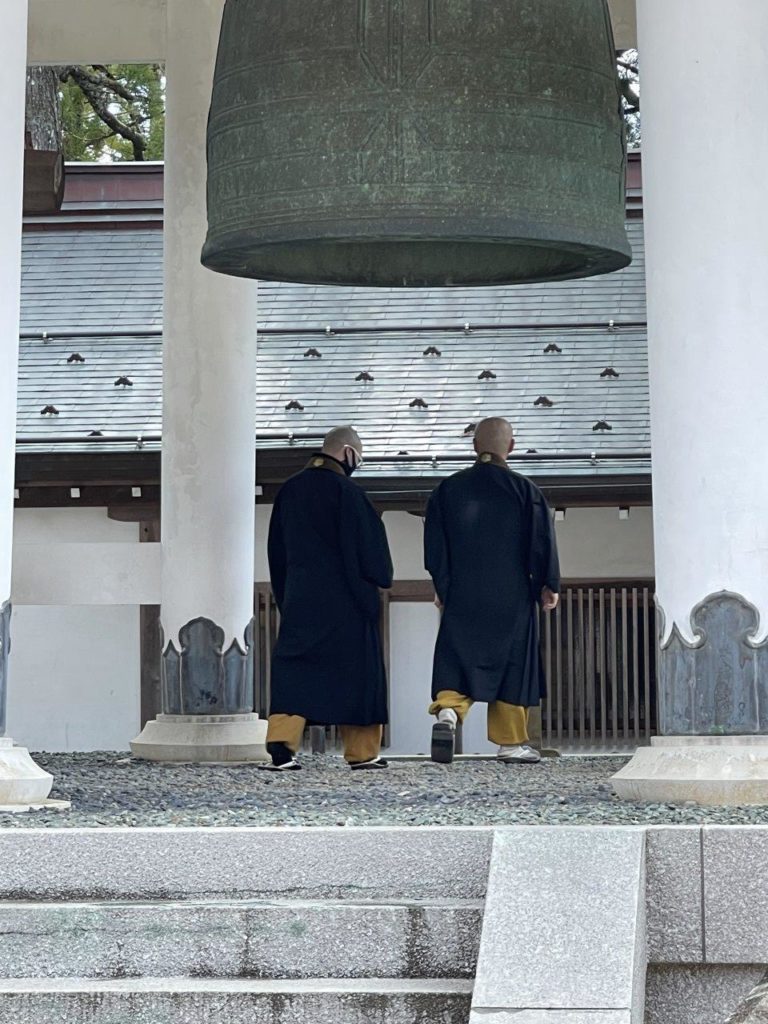

We were enchanted by the sound of the bells and the silence between strikes. I started counting, but got so engrossed that I lost count.
A shukubo is a traditional Japanese temple guesthouse that’s run by Buddhist temples. Hongaku-in Temple, a Buddhist monastery, is our lodging tonight. This shukubo was built in 1190. Though in no way upscale in accommodations, we were treated to times past. Close your eyes and imagine being a devoted monk, with a slow-paced lifestyle, and simple, but tasty Buddhist vegetarian cuisine. Ring a bell or two. Being devout, there’s an early morning (6:30) Buddhist ceremonial meditation to start your day.
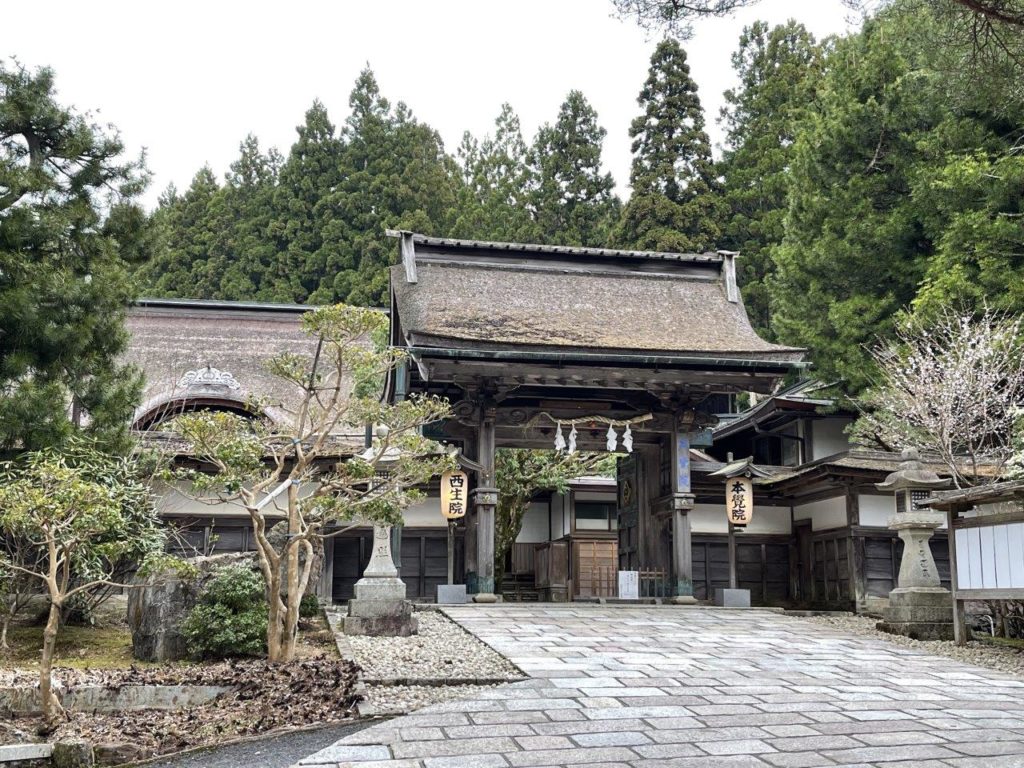
I had every intention of attending the morning meditation, but couldn’t bear facing the freezing cold halls leading to it. Being at over 3,000 feet above sea level, temperatures drop to just above freezing; making my down comforter so cozy and cuddly lying underneath it, and leaving its warm embrace for anything else just nonsensical. I will say a little prayer at breakfast.

*** My definition of meditation: To give THANKS to the Universe for all, my gifts and blessings. Repeated daily.
Our large tatami covered room was in true, spare Japanese style; a sitting table and cushions would be converted over to a sleeping room during our time at dinner.

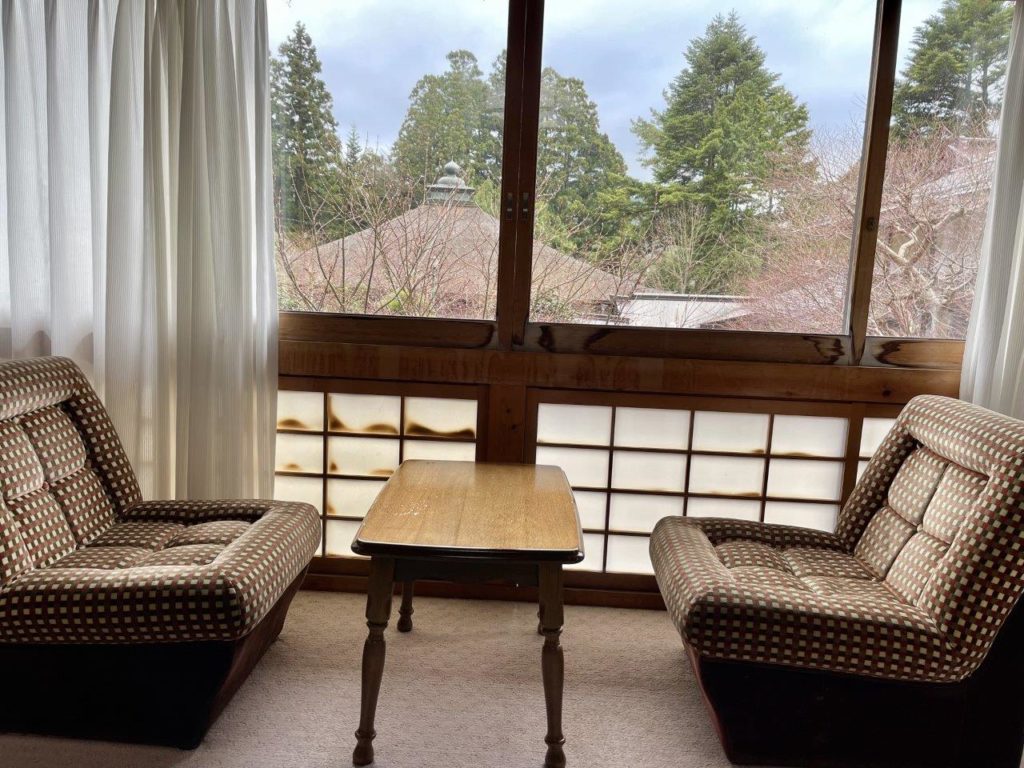
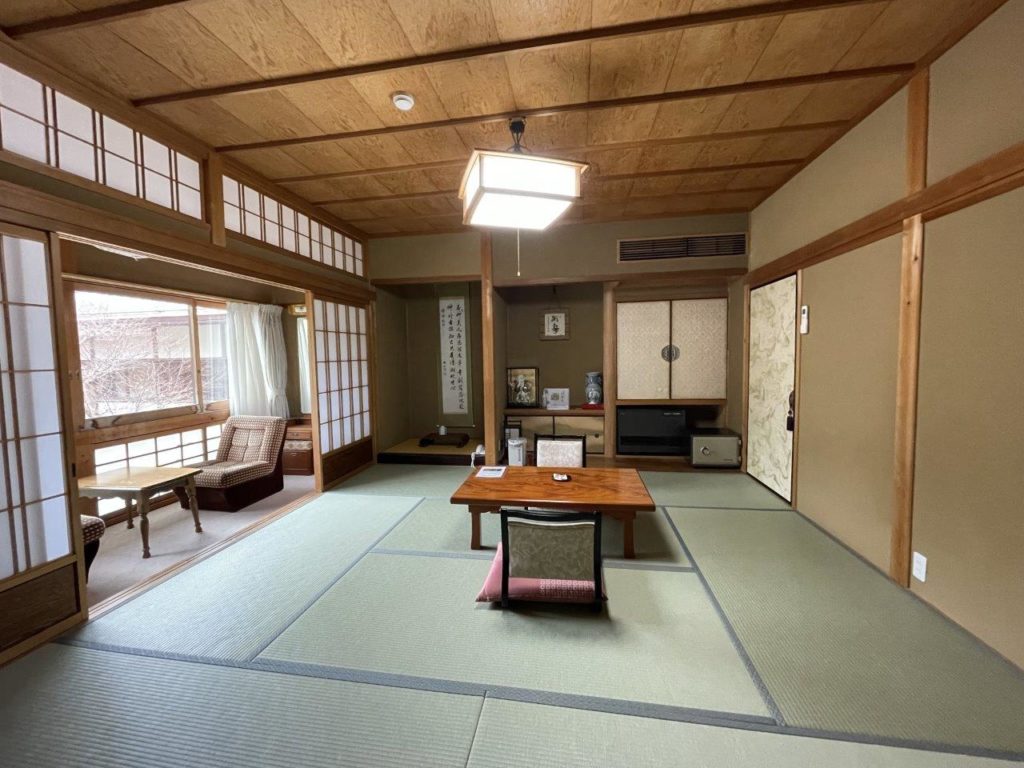
Meanwhile, at dinner, David has problems sitting cross-legged on the floor, so the monks arranged a stacked pile of trays for him so he could then comfortably sit in a small chair. I was fine sitting on the floor as he loomed over me like a giant. Dinner was simple, with very enjoyable vegetarian dishes and beautifully presented. Anything less would be sacrilegious.






Checking out the next morning, we had to find our shoes at the front entrance. They were very cold from being outside in the chilly air. Oh, the sacrifices one must make.
Mount Koya was a fascinating and deeply spiritual destination with a rich history and a wide variety of temples and monasteries to explore. Its quiet devotion to its religious ties gave us pause to consider in a crazy mixed-up world. Here, high up in the heavens, things slow down and bring peaceful contentment.
A two-hour drive will bring us back to Osaka Station for our last Shinkansen to Tokyo.
As seen on the streets…..



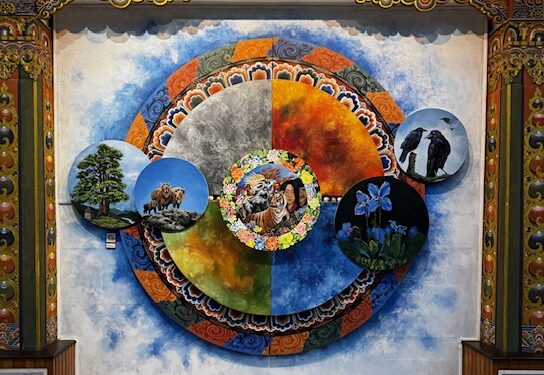
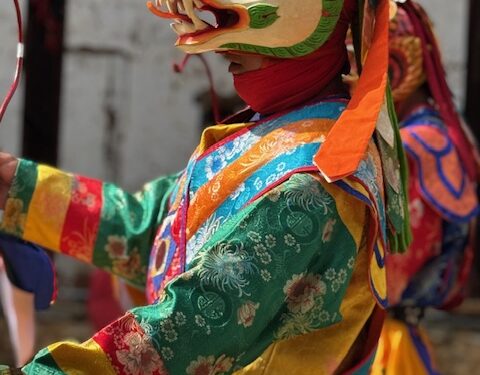
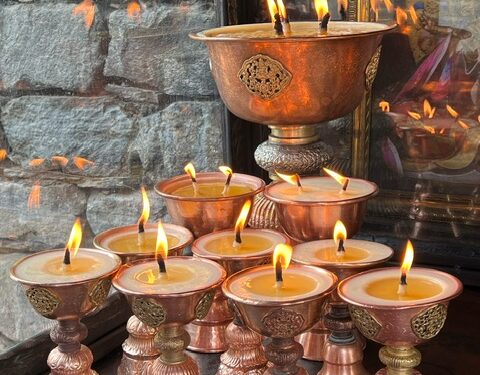


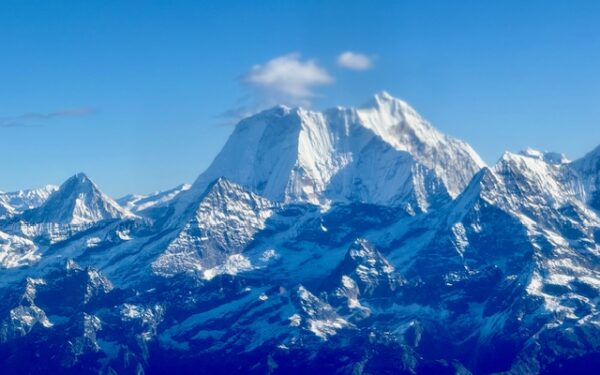
Dotonburi. Daimaru. Shinsaibashi. The lights, colors, foods and throngs of people superbly combine for a glimpse of vibrant Osaka. Btw, great photo of you and David happily posing in front of iconic Glico Man.
40-story Umeda Sky Building’s breathtaking views, as well as trains with rotating seats… reminders of Japanese ingenuity.
The serenity of Buddhism is clearly evident in Mt Koya’s temples, grounds, statues and art. Meditative. Peaceful. Calm.
As Seen… old meets new. Traditional Tabi socks with a twist to black and white edgy!
Thank you for sharing more of your fascinating look at Japan, Sergio and David.
What an amazing trip! Excellent piece.
Bento boxes, GRATITUDE and yes, I found David comfortably placed behind the lady with the red ( pink?) shirt on🥹
Love it!! Love all your pics!!❤️❤️❤️❤️
Love it!! Love all your pics!!❤️❤️❤️❤️
Another fabulous adventure recounted. Loved your commentary, as usual. Notes: Too bad the octopus balls did not work out well for you this time. Like David I would always opt for an egg custard tart. The auto-directional switching of the train seating sounds genius. The temples look peaceful especially with the surrounding raked gardens. The temple art was amazing!
These pictures and explanations are absolutely outstanding! Thankyou so much for sharing your experience. I feel like I am taking this trip with you two. Many thanks!!
What an amazing trip! Excellent piece.
David looks like a king sitting up there…or a Buddha on his pedestal. I had quite a different initial take on what octopus balls were going to be! Bet you knew that when you chose to explain them a bit later in your commentary! What a trip you had. Phew! I need to rest up just from reading it…Thanks for sharing.
I am amazed by how many incredible places you went and experiences you-had-
this last post seems like a whole new trip so many experiences- and beautiful places0
thank you again for your generous sharing
xo- Erin
Such energy and stamina you two have! An amazing series of journeys with fascinating experiences in all, how long did it take you to “ come back down to Earth?”
This had everything you could ever ask for in a vacation. History, great food, beautiful nature, and time to reflect and meditate. Love it!
Sergio and David, I truly enjoy your posts and find myself using them as a point of reference for my vacation. Thanks for the all encompassing information on all things nature , food, shopping, cultural and spiritual activities. Headed to Japan next month. Please continue to share.